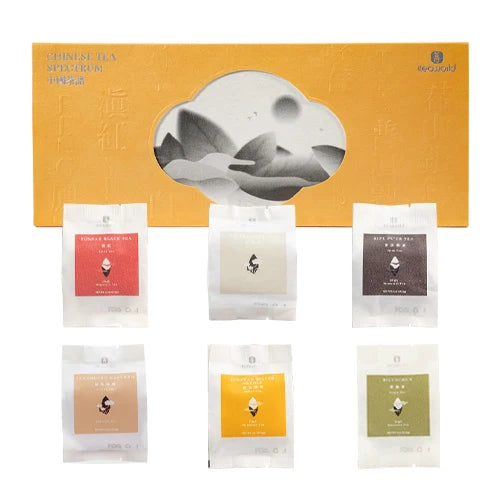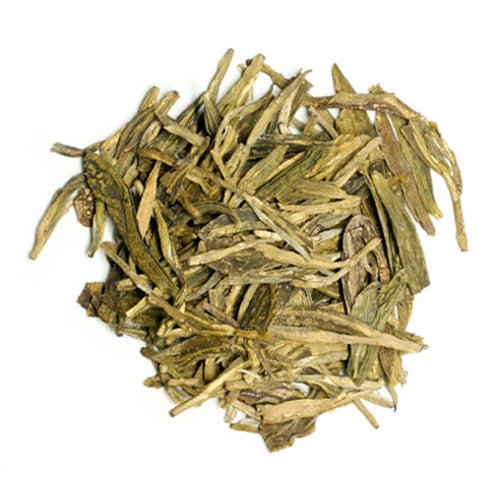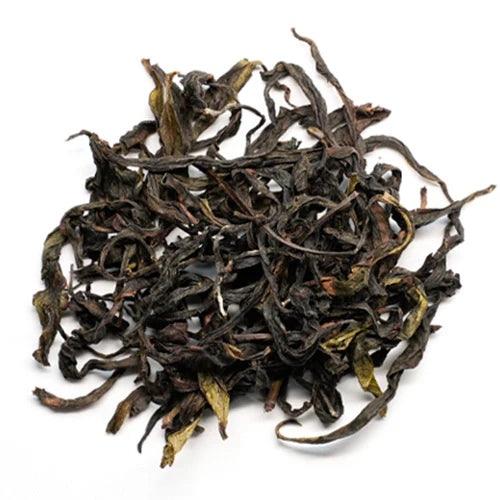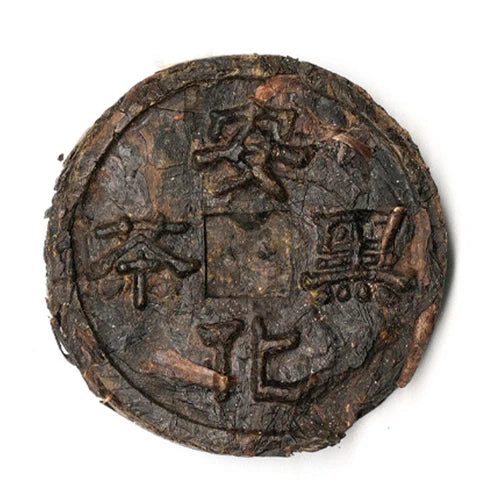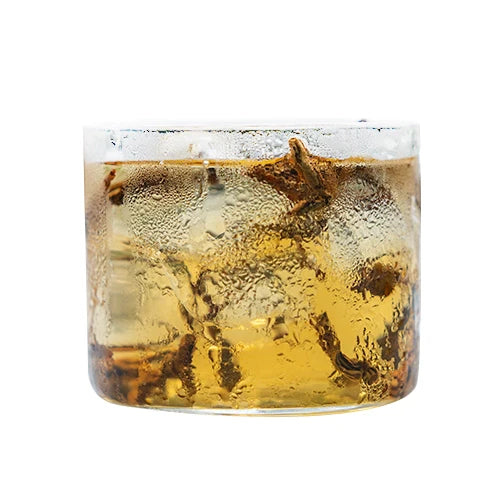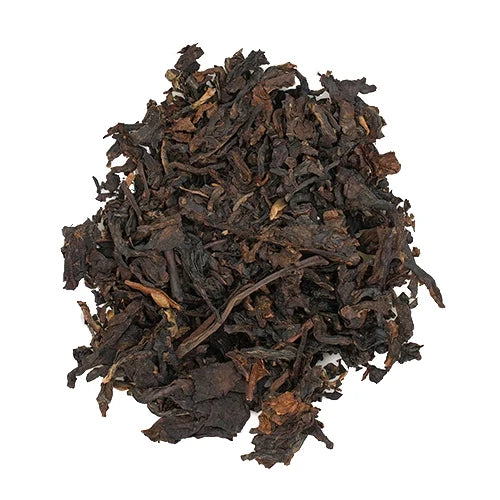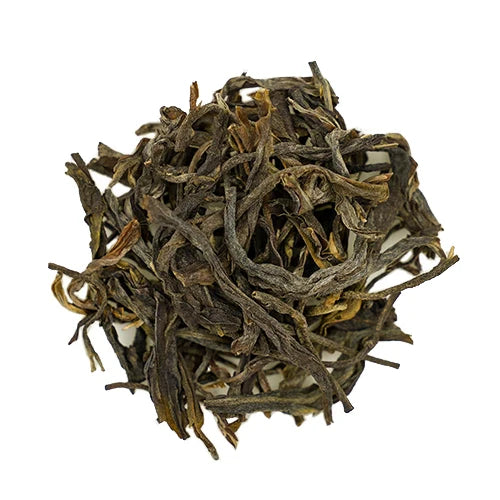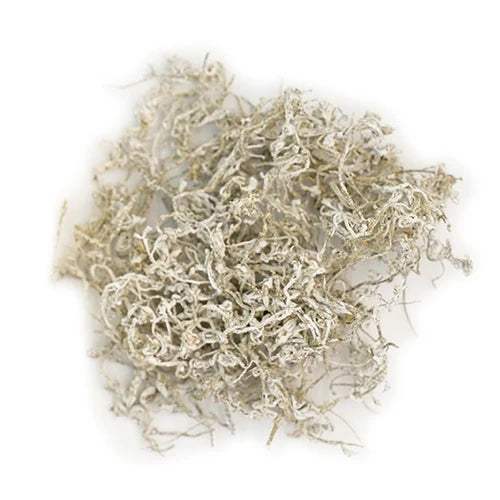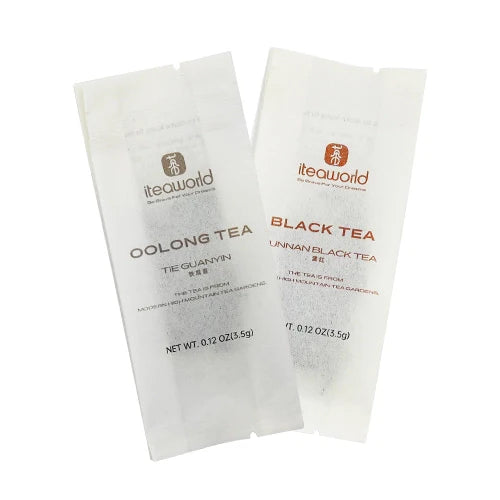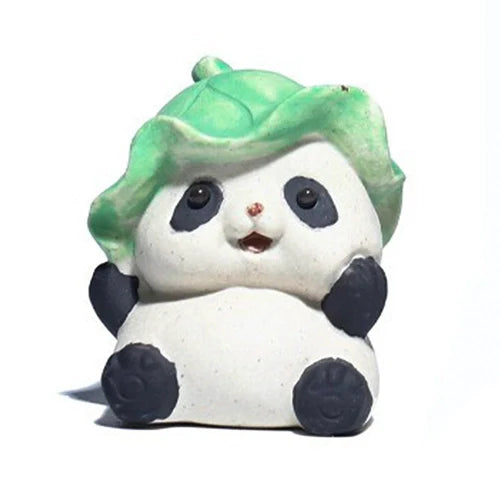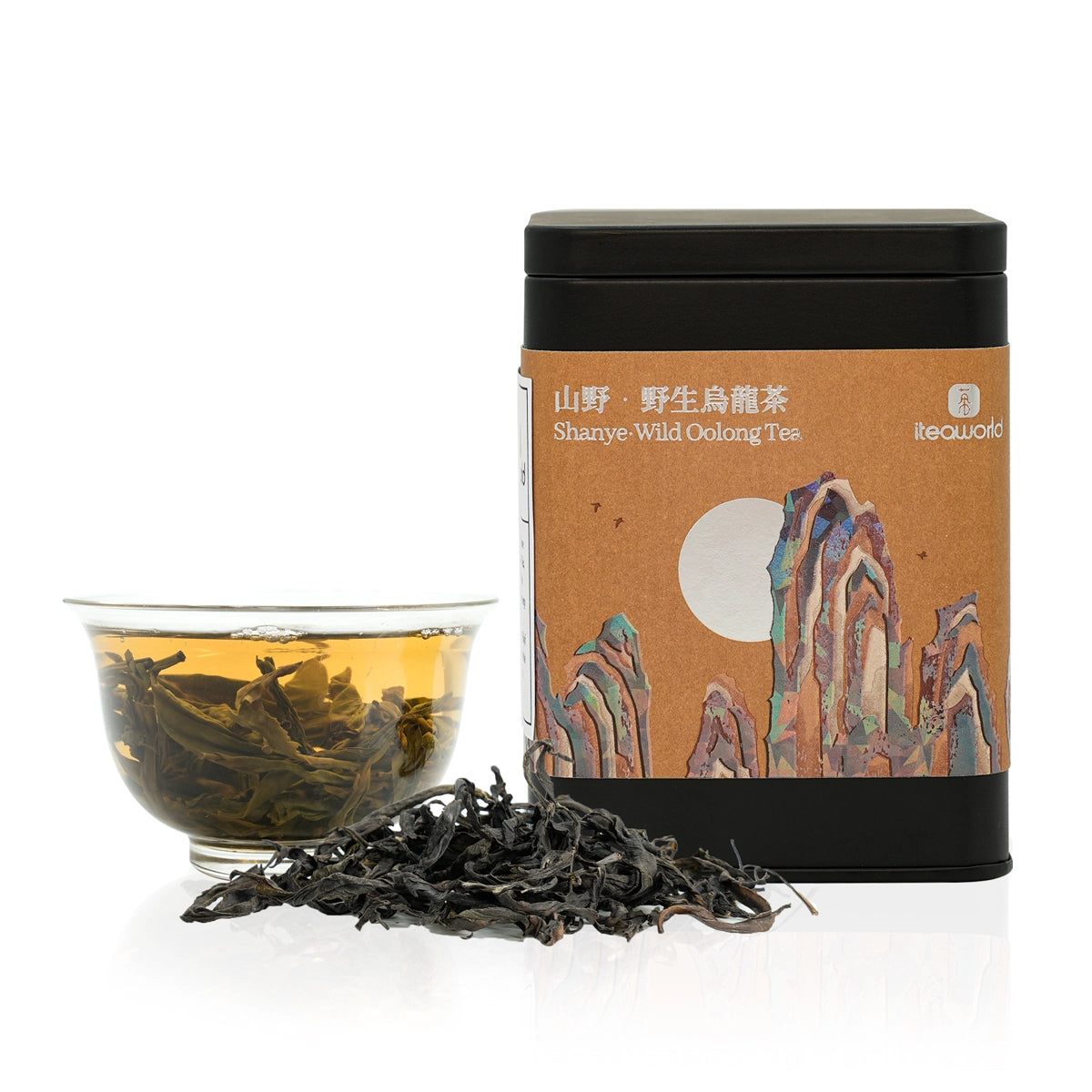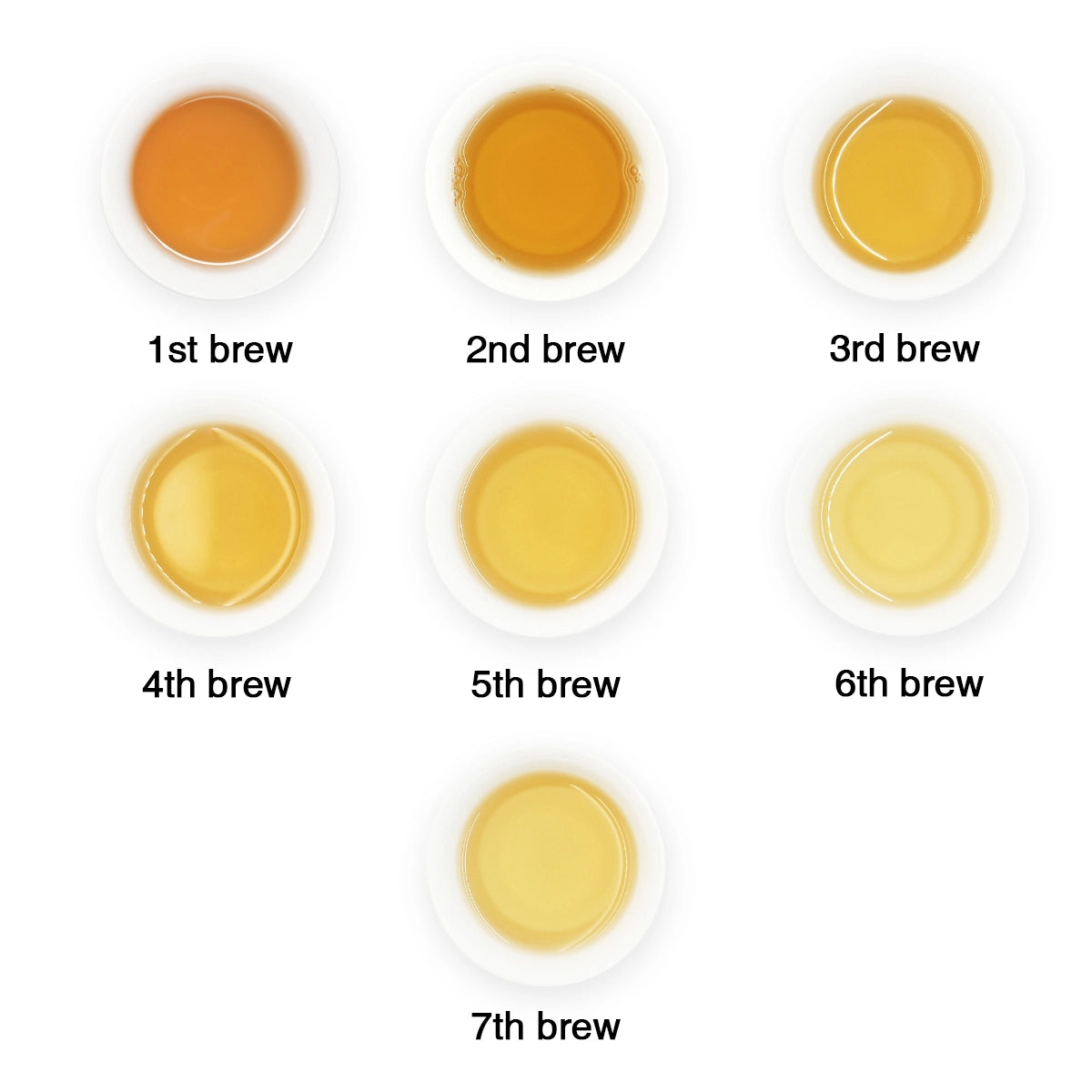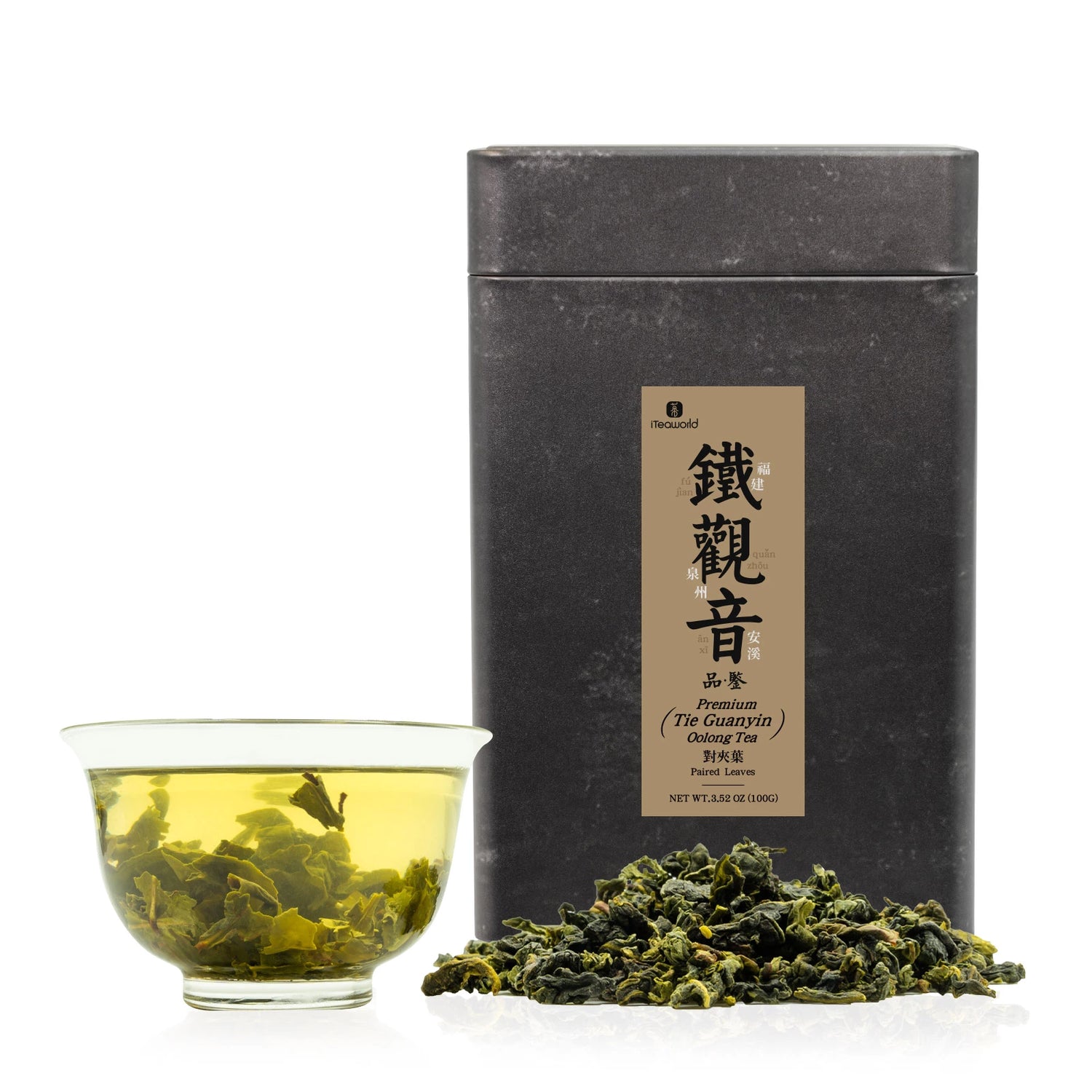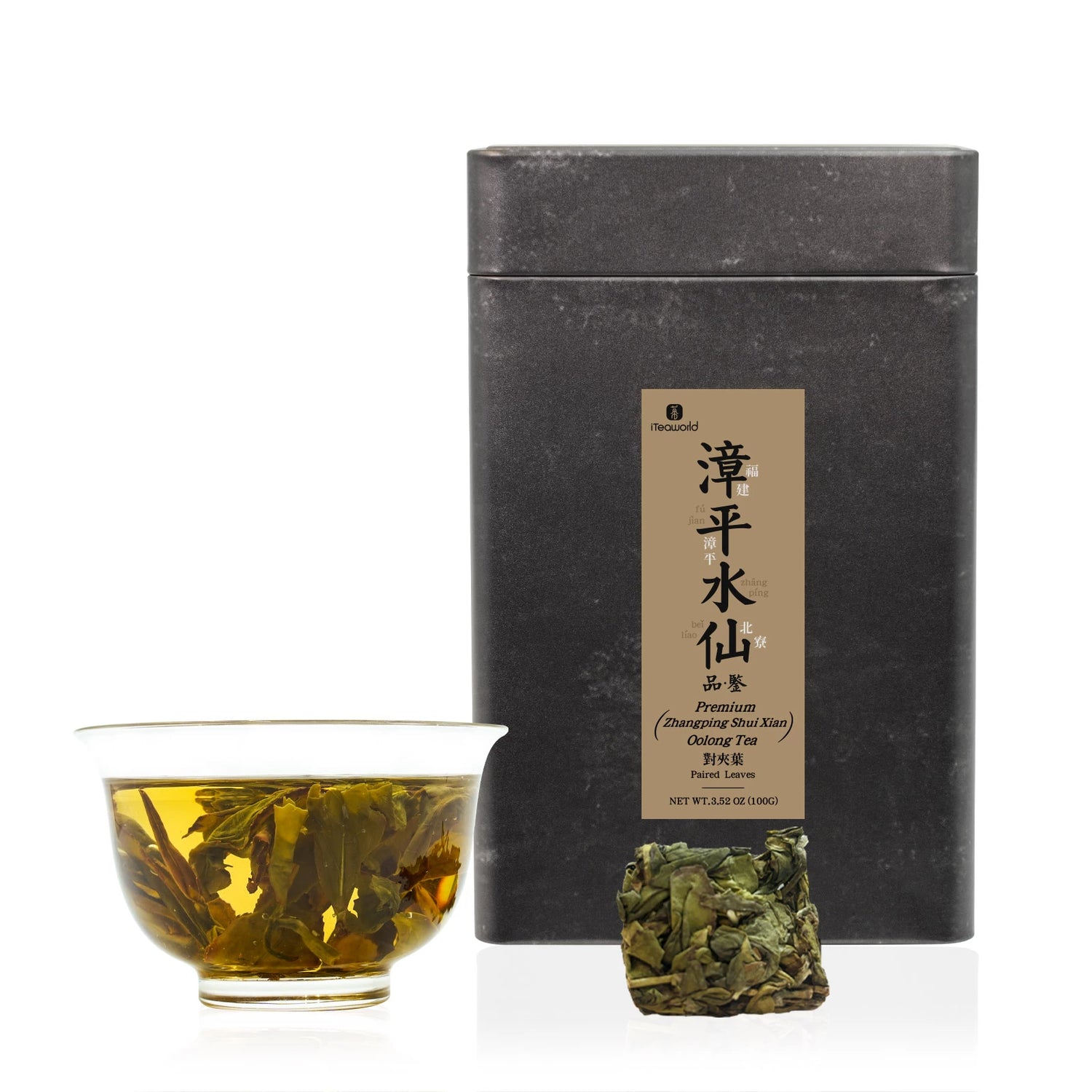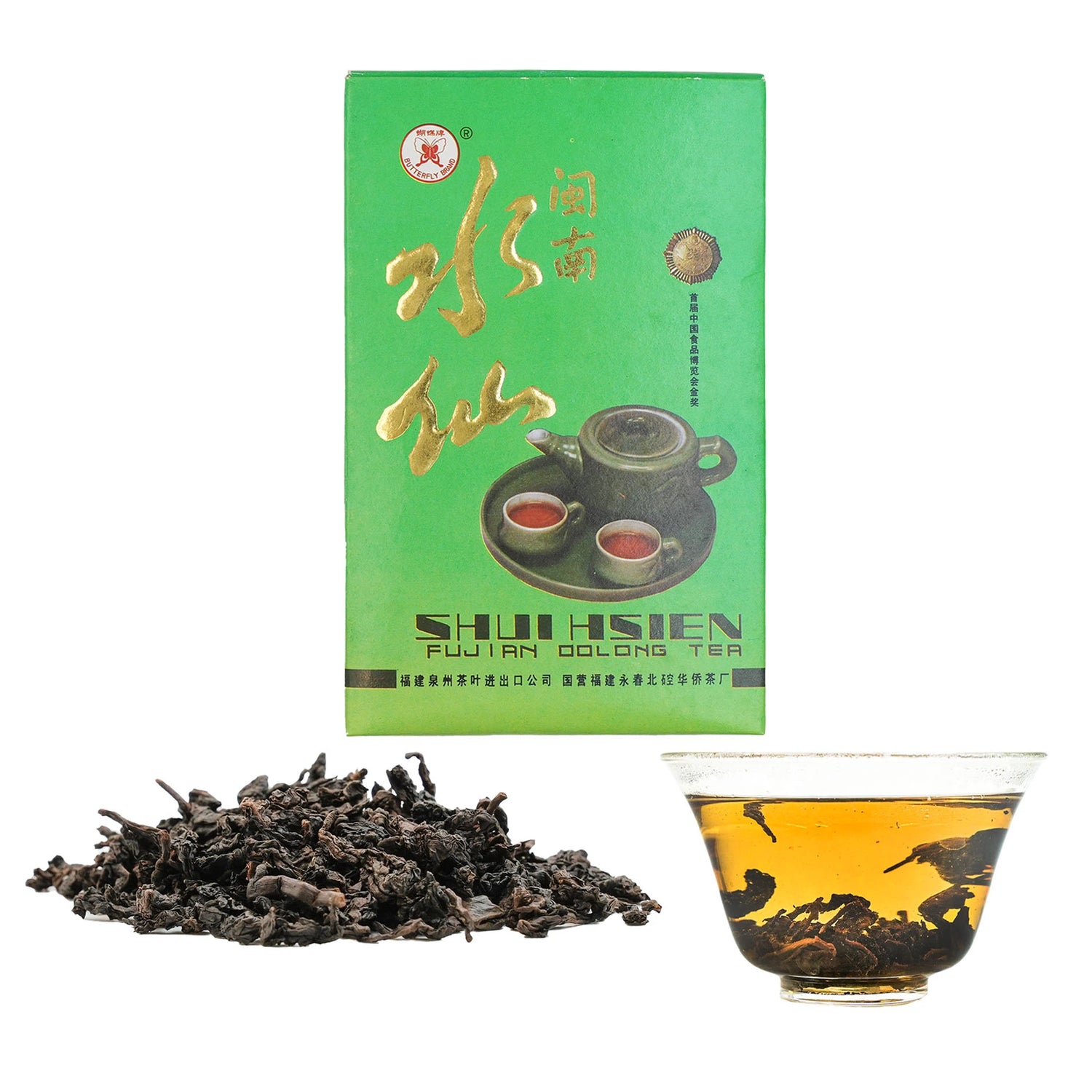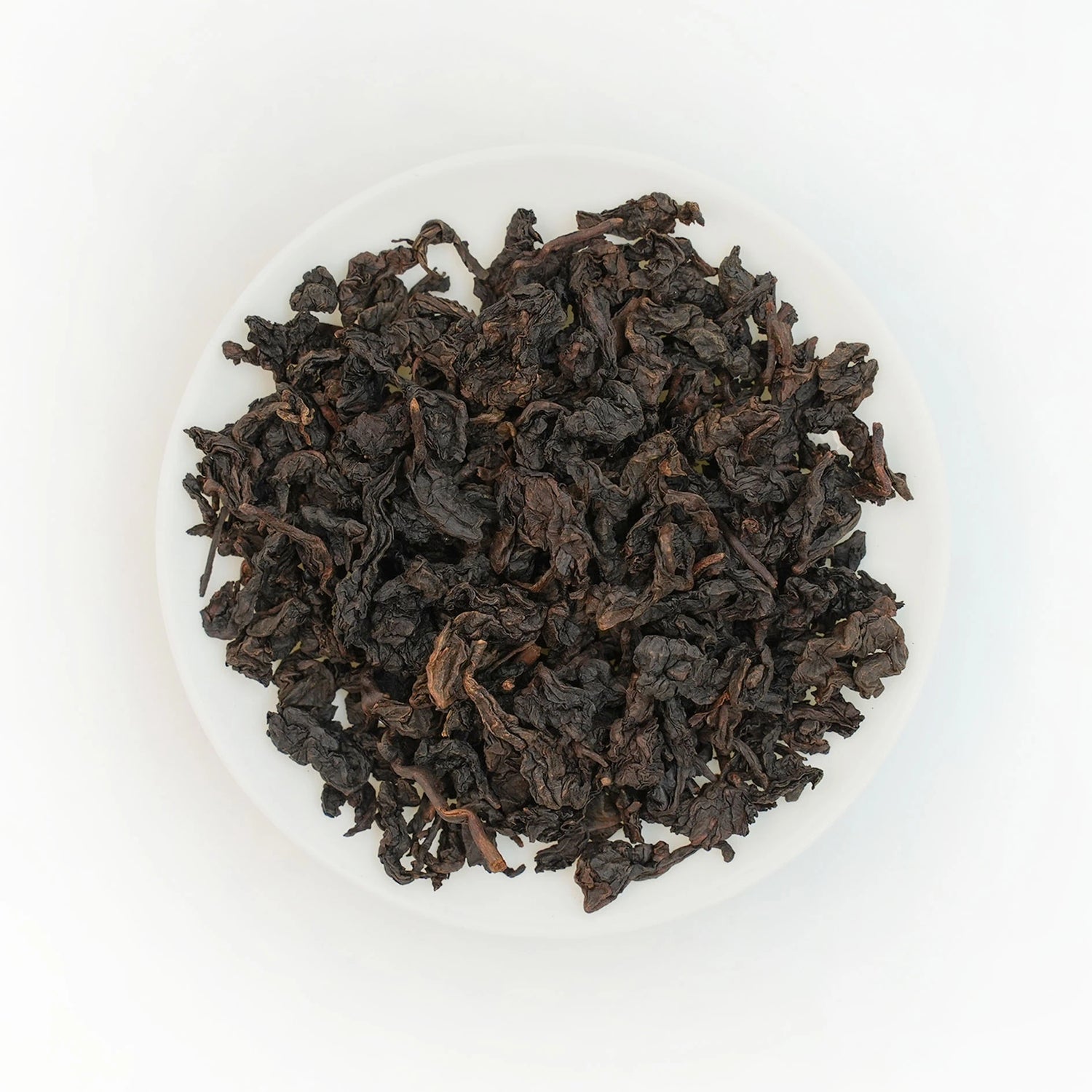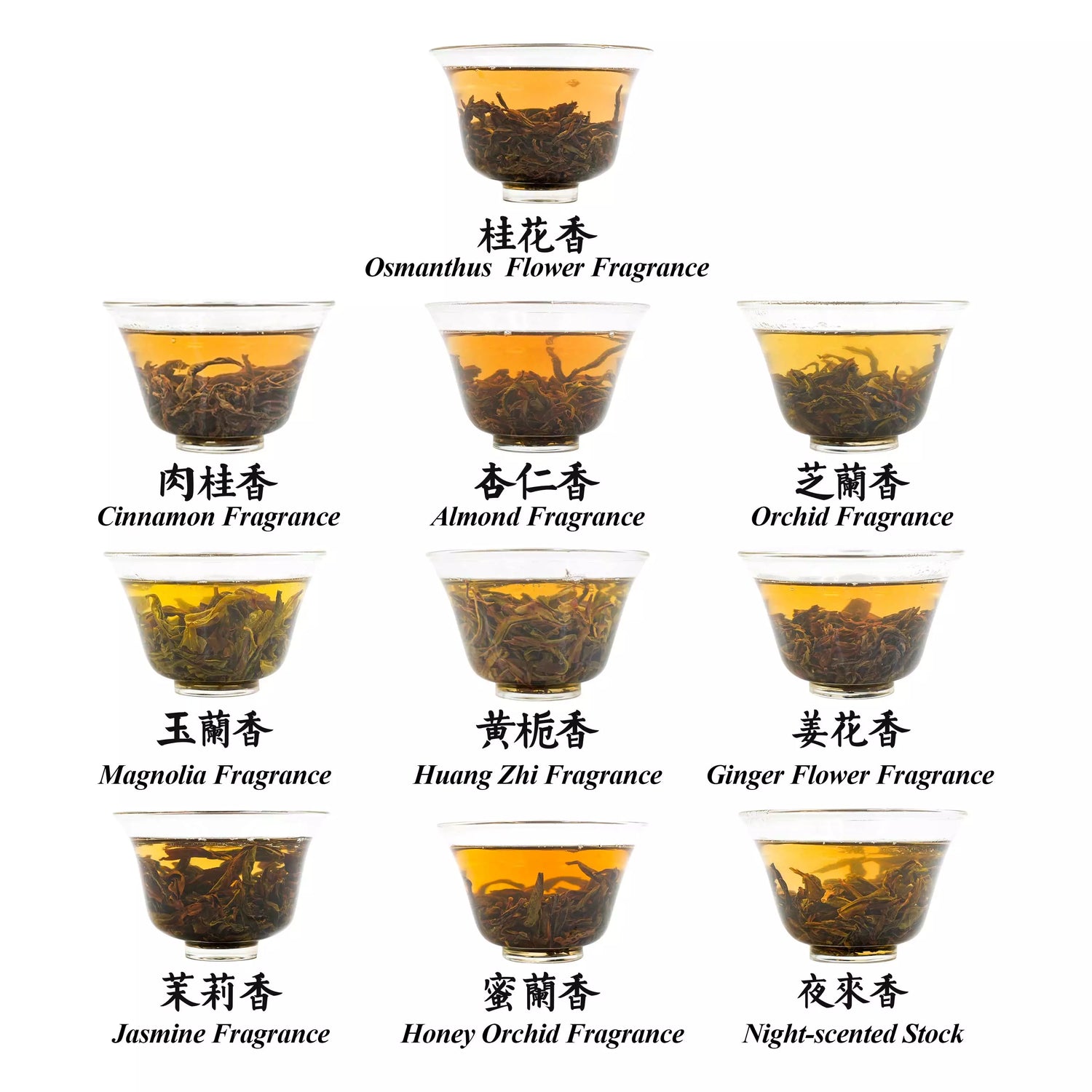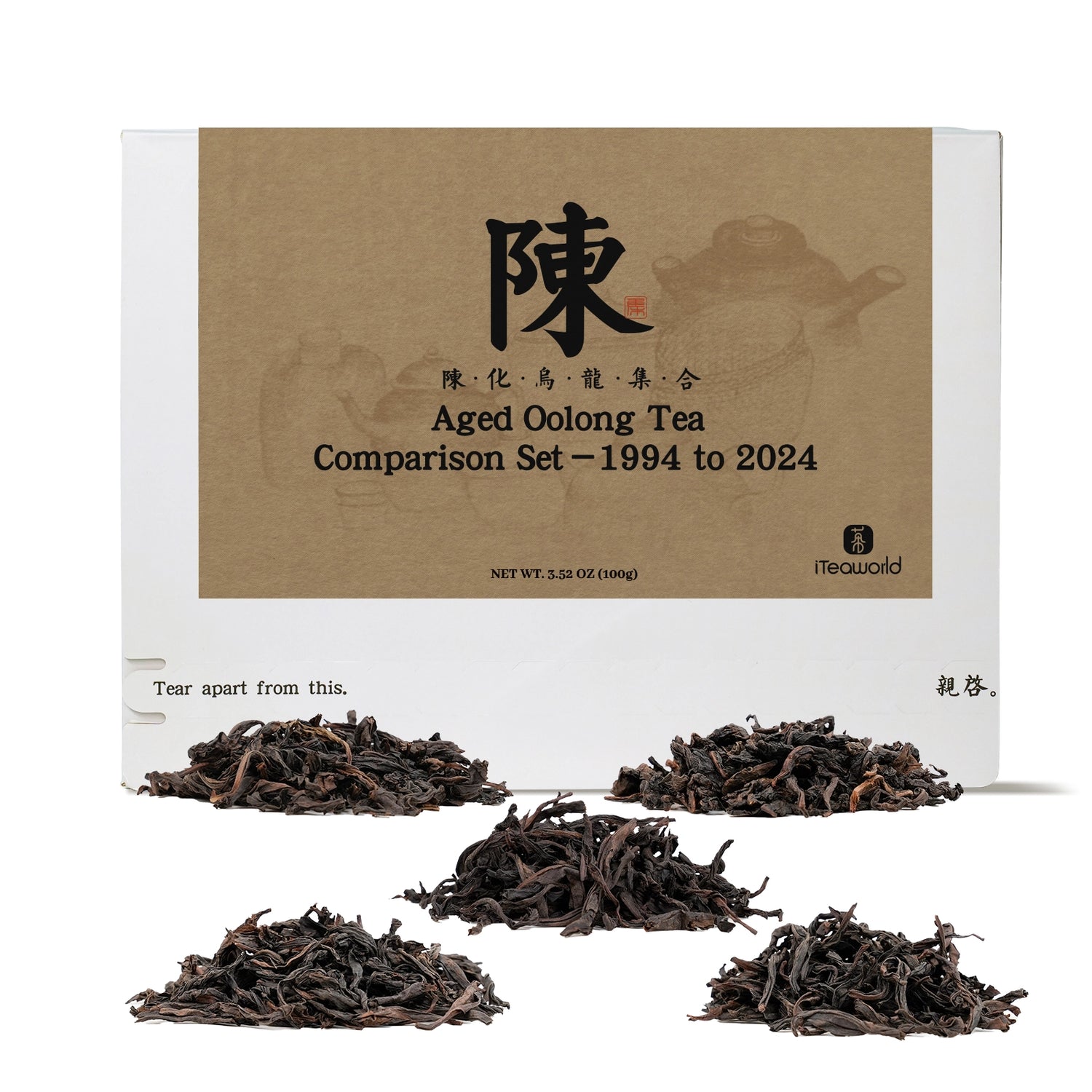Сортировать по:
71 продукта
71 продукта
Дикий улун , произведенный в деревне Ли Цзян, уезд Луншэн , Гуйлинь, Гуанси . Окруженный горами со всех сторон, регион может похвастаться богатой органической почвой , сильным солнечным светом и частыми осадками на высоте около 1000 метров . Выращенный в нетронутой экологической среде с обильной растительностью, этот дикий улун культивируется без химических удобрений и пестицидов , что приводит к ограниченному урожаю — только один весенний урожай в год . Обработанный с использованием технологий чая из скалы Уи , он предлагает богатый цветочно-фруктовый аромат с душистым настоем и взрывом цветочно-фруктовых нот при дегустации. Настой ярко-оранжево-красный с явными золотистыми кольцами .
Введение:
Этот премиальный Тегуаньинь тщательно отобран из осеннего урожая 2023 года. Собранный с высокогорных чайных плантаций в Аньси, Фуцзянь (самое аутентичное происхождение), исключительные условия выращивания придают богатый и крепкий вкусовой профиль. Тщательно изготовленный небольшими партиями профессиональными чайными фермерами, этот чай гарантирует мягкий, мягкий вкус с сильным ароматом орхидеи.
Причины рекомендовать:
- Знаменитый китайский чай: Anxi Tieguanyin, возникший около 1725 года, входит в десятку самых известных чаев Китая. 22 мая 2023 года Anxi Tieguanyin был награжден сертификатом «Глобально важные системы сельскохозяйственного наследия».
- Подлинное происхождение: Выращено в Аньси, провинция Фуцзянь, где горная местность и туманный климат создают среднегодовую температуру 15-18°C, безморозный период 260-324 дня и годовое количество осадков 1700-1900 мм. Относительная влажность превышает 78%, а кислая красная почва, богатая органическими веществами и минералами, способствует уникальному вкусу чайных деревьев Тегуаньинь.
- Высокогорные чайные сады: по сравнению с другими чаями Тегуаньинь, этот сорт выращивается в высокогорных садах в Аньси, где прекрасный климат усиливает насыщенность чая, обеспечивая более мягкое, сладкое послевкусие и более интенсивный аромат.
- Тщательное мастерство: этот чай тщательно производится небольшими партиями опытными фермерами и проходит множество сложных процессов для достижения высочайшего качества.
Степень окисления: 15%-25%
Степень обжарки: легкая обжарка
Почва чайной плантации: красная почва
Время обработки: ноябрь 2024 г.
Срок годности: 36 месяцев
Сорт чая: Тегуаньинь
Введение:
Этот Qidan Da Hong Pao тщательно отобран из весеннего урожая 2023 года. Получен из чистейшего чая Wuyi в горах Wuyi, Фуцзянь (самое аутентичное происхождение), исключительные условия выращивания и особый сорт придают действительно аутентичный вкусовой профиль. Созданный мастером-чайником Чэнь Хай, имеющим многолетний опыт, этот чай гарантирует насыщенное сладкое послевкусие с тонким ароматом османтуса.
Причины рекомендовать:
- Основная производственная зона: выращивается в самом сердце горы Уи, провинция Фуцзянь, где среднегодовая температура колеблется от 16°C до 25°C, безморозный период длится 253-272 дня, а годовое количество осадков составляет около 2000 мм. Относительная влажность воздуха составляет 78%-84%, а кислая красная почва, богатая органическими веществами и минералами, придает уникальный вкус чайным деревьям Да Хун Пао.
- Чистый сорт: Материнские деревья Да Хун Пао растут на крутых скалах Цзюлунке в заповеднике горы Уи. Из-за их ограниченной урожайности и исключительного качества чистокровный Да Хун Пао размножается бесполым путем из черенков этих материнских деревьев и обрабатывается отдельно.
- Высокогорные чайные плантации: этот чай выращивается в высокогорных садах горы Уи, где прекрасный климат усиливает насыщенность чая, обеспечивая более полное, сладкое послевкусие и более интенсивный, стойкий аромат с ярко выраженной «горной эссенцией».
- Уникальный процесс обжарки: отборные чайные листья медленно обжариваются при слабом нагревании, приобретая сладкий аромат с легким дымным оттенком.
Степень окисления: 45%-55%
Степень обжарки: от легкой до средней
Почва чайного сада: песчано-гравийная почва
Мастер купажа: Чэнь Хай
Время обработки: первоначальная обработка в мае 2024 г., уточнение в сентябре 2024 г.
Срок годности: 36 месяцев
Сорт чая: Цидань
Введение:
Этот улун квадратной формы Zhangping Shuixian тщательно отобран из весеннего урожая 2023 года и изготовлен лучшим мастером чая с использованием уникальных традиционных методов. Собранный в высокогорных чайных садах в Чжанпине, провинция Фуцзянь, на высоте около 600 метров, исключительные условия выращивания придают этому чаю насыщенный и мягкий вкус. Стандарт сбора в первую очередь одной почки и двух листьев обеспечивает сильный аромат орхидеи, мягкий и освежающий вкус и яркий золотистый ликер.
Причины рекомендовать:
- Основная зона производства: выращивается в Чжанпине, провинция Фуцзянь, где климат теплый, влажный и обильный осадками, с мягкой зимой и прохладным летом. Среднегодовая температура колеблется от 16,9°C до 20,7°C, годовое количество осадков 1450-2100 мм, безморозный период 251-317 дней и средняя годовая продолжительность солнечного сияния 1853 часа, что обеспечивает идеальные природные условия для производства чая.
- Уникальная форма: Чайные блины Zhangping Shuixian сочетают в себе методы производства Minbei Shuixian и Minnan Tieguanyin. Спрессованный в квадратные блины с использованием деревянных форм, это единственный прессованный чай в категории улун, предлагающий уникальный стиль и богатый традиционный вкус.
- Традиционный процесс ручной работы: Этот Zhangping Shuixian является шедевром традиционного ручного изготовления чая. Мастер настаивает на использовании ручных методов и традиционной обжарки на угле для сушки, сохраняя подлинное мастерство чая Zhangping Shuixian.
Степень окисления: от легкой до средней (25%-30%)
Степень обжарки: легкая обжарка (70-80°C)
Почва чайной плантации: желто-красная почва
Мастер купажа: Хэ Мэйцин
Время обработки: июнь 2024 г.
Срок годности: 24 месяца
Сорт чая: Миннан Шуйсянь
Рекомендуемая покупка :
Этот чай Те Гуань Инь Улун, произведенный между 1990 и 1993 годами, хранился на сухом складе старой чайной фабрики более тридцати лет и был запечатан. Он изготовлен из сорта Те Гуань Инь из знаменитого чаеводческого региона Юнчунь, провинция Фуцзянь, и был изготовлен государственной фабрикой Yongchun Kong Overseas Chinese Tea Factory, основанной в 1958 году. Этот чай полностью изготовлен вручную, традиционно обжарен на сильном огне и поставляется в оригинальной упаковке. Больше не продается на рынке, его уникальный «выдержанный аромат», насыщенная сладость и гладкая текстура делают его ценным выбором для ценителей выдержанного чая улун.
Основные сведения о Тегуаньинь:
- Дата производства : 1990-1993
- Класс: Первый класс
- Сорт чая : Тегуаньинь
- Мастерство : Этот чай традиционно обжаривается на полном огне и умеренно окисляется. После более чем тридцати лет естественной выдержки в сухой среде хранения он запечатывается во внешнюю бумажную коробку и упаковывается во внутренний крафт-бумажный пакет.
- Вкусовые особенности : Этот чай обладает богатым, выдержанным ароматом с оттенками древесных нот. Текстура густая и гладкая, с глубоким, мягким вкусом и длительным сладким послевкусием. Его сложный профиль раскрывается слоями, что делает его по-настоящему изысканным опытом.
Что такое чай Тегуаньинь Улун? :
Tieguanyin — один из десяти самых известных чаев Китая, полуферментированный улун, в основном производимый в Аньси, провинция Фуцзянь. Его уникальный процесс производства включает в себя завяливание на солнце, встряхивание и нагревание, что придает листьям характерный вид «зеленого листа с красными краями». Чай отличается плотно скрученными песчано-зелеными листьями и золотистым прозрачным настоем. Он имеет насыщенный, стойкий аромат с натуральными нотами орхидеи или фруктов, мягкий, освежающий вкус и сладкое послевкусие. Tieguanyin, обладающий высокой устойчивостью к многократным завариваниям, наполнен питательными веществами, такими как полифенолы и аминокислоты, предлагая такие преимущества, как повышение бдительности, снижение усталости, охлаждение тела и помощь в потере веса. Этот ценный чай и символ чайной культуры Южной Фуцзянь широко любим любителями чая.
Советы по завариванию и наслаждению:
Этот чай демонстрирует уникальную трансформацию, которую приносит время. Первое заваривание можно использовать как шаг «пробуждения чая», чтобы активировать внутренние качества чая, что приводит к более богатой, гладкой текстуре и более выраженному сладкому послевкусию. Для лучшего опыта мы рекомендуем использовать более длительное время заваривания или методы кипячения, чтобы полностью раскрыть его выдержанные характеристики.
Рекомендуемые методы заваривания:
-
Гайвань Пивоварение
- Емкость : 100 мл Гайвань
- Температура воды : 95 ℃ -100 ℃
- Время заваривания : 5-7 раз
- Соотношение чая и воды : от 1:15 до 1:25
- Время заваривания Один раз : 10 ~20 секунд
-
Термос для заваривания
- 1 г чая на 100 мл (3,4 унции) воды.
- Используйте кипящую воду (212°F).
- Время настаивания: 1-2 часа.
- Инструмент: Изолированный термос.
-
Метод кипячения
- Добавьте 1 г чая на 100 мл (3,4 жидких унции) воды.
- Кипятите 1–2 минуты, затем дайте постоять 2–3 минуты.
- Повторно заваривайте, кипятя на 3 минуты дольше с каждым завариванием.
- Для оптимального вкуса используйте керамический или стеклянный чайник.
- Наслаждайтесь 3–4 порциями кофе.
Правила хранения:
Чтобы обеспечить наилучшее качество чая, идеальный способ хранения — хранить его в вакуумной упаковке в прохладном, темном и сухом месте. Избегайте воздействия сильных запахов и воздуха. Для герметичного хранения рекомендуется использовать жестяную банку или металлическую банку с двойной крышкой. Для еще лучшего результата вы можете хранить герметично закрытый чай в холодильнике или сухом контейнере для хранения.
Вес и упаковка
- Вес: 3,5 унции ( 100 г)
- Тип упаковки : Запечатанная бумажная коробка с упаковкой из коровьей кожи внутри
О зарубежной китайской чайной фабрике Yongchun Beikeng:
Основанная в 1958 году государственная фабрика чая Fujian Yongchun Beikeng Overseas Chinese Tea Factory имеет богатую историю и культурное наследие производства чая. На пике своего развития фабрика была оживленным центром инноваций и мастерства, на ней работало более 1000 рабочих чайной отрасли, и ежегодно производились миллионы фунтов чая. Ее чаи, включая Tieguanyin, экспортировались в Гонконг, Тайвань, Японию и Юго-Восточную Азию, заслужив широкое признание и став ярким символом чайной культуры Фуцзянь.
Однако к 1990-м годам фабрика пришла в упадок, а ее некогда оживленные земли затихли. Не в силах вынести, как угасает дело его жизни, ветеран-директор фабрики Хуан Шэнхоу взял на себя управление после ее приватизации, посвятив себя возрождению фабрики и сохранению ее чайного наследия.
Сегодня выдержанный Тегуаньинь фабрики не только воплощает в себе десятилетия опыта в изготовлении чая, но и продолжает демонстрировать непреходящее очарование Тегуаньинь из Юнчуня. История фабрики заграничного китайского чая Фуцзянь Юнчунь Бэйкэн отражает преданность и новаторство поколений мастеров чайного дела, а ее выдержанный Тегуаньинь продолжает это замечательное наследие.
Рекомендуемая покупка
Этот чай улун южной Фуцзянь Шуйсянь, произведенный в период с 1993 по 1995 год и выдержанный более 30 лет на сухом складе в герметичных условиях, изготовлен из сорта Шуйсянь (Нарцисс), полученного из Юнчуня, провинция Фуцзянь — родины этого чая. Он был совместно произведен компанией Quanzhou Tea Import & Export Company и государственной китайской чайной фабрикой Yongchun Kong Overseas в Фуцзяне.
Обработанный по методу Юнчунь Шуйсянь, этот чай является классическим примером чая Улун, сохраненного в оригинальной упаковке. Он больше не доступен на рынке. Чай демонстрирует отчетливый выдержанный аромат, сопровождаемый тонким лекарственным ароматом, со сладким, мягким вкусом и гладкой текстурой. Его превосходные результаты выдержки делают его ценным выбором для любителей выдержанного чая Улун.
Ключевые сведения о Южном Фуцзянь Шуйсяне
- Происхождение: Юнчунь, провинция Фуцзянь, Китай.
- Дата производства: 1993-1995
- Класс: Первый класс
- Сорт чая: Шуй Сянь
- Мастерство: Этот чай перерабатывается в улун методом Юн Чунь Шуй Сянь с умеренной ферментацией. Он выдерживается естественным образом в сухой среде хранения более 30 лет. Чай упакован в оригинальную запечатанную картонную коробку с внутренним слоем алюминиевой фольги для дополнительной защиты.
- Вкусовые особенности: Чай демонстрирует отчетливый выдержанный аромат, сопровождаемый тонким лекарственным ароматом. Его вкус сладкий и мягкий, с гладкой текстурой, демонстрирующей превосходные эффекты выдержки.
Что такое чай «Южный Фуцзянь Шуйсянь»?
Чай Southern Fujian Shui Xian возник в Северной Фуцзяни и был представлен Юн Чуню в период Даогуан династии Цин. Со временем методы его обработки развивались путем смешивания характеристик северных и южных фуцзяньских улунских чаев, что привело к уникальному методу, который увеличивает стойкость чая для многократных завариваний, усиливает его орхидееподобный аромат и производит ярко-желтый ликер со сладким, мягким и освежающим вкусом. Помимо своего исключительного вкуса, чай Southern Fujian Shui Xian предлагает многочисленные преимущества для здоровья, такие как активация автономной нервной системы, снижение стресса, улучшение энергетического обмена, расщепление жиров и снижение уровня холестерина, что делает его желанным выбором как для любителей чая, так и для людей, заботящихся о своем здоровье.
Советы по завариванию и наслаждению
Этот чай демонстрирует уникальную трансформацию, которую приносит время. Первое заваривание можно использовать как шаг «пробуждения чая», чтобы активировать внутренние качества чая, что приводит к более богатой, гладкой текстуре и более выраженному сладкому послевкусию. Для лучшего опыта мы рекомендуем использовать более длительное время заваривания или методы кипячения, чтобы полностью раскрыть его выдержанные характеристики.
Рекомендуемые методы заваривания
Гайваньское пивоварение:
- Емкость: 110 мл Гайвань
- Температура воды: 100℃
- Время заваривания: 5-7 раз
- Соотношение чая и воды: 1:22
- Время заваривания Один раз:Для заваривания начните с быстрого ополаскивания (1-2 секунды) и слейте жидкость. Для первых трех заварок заваривайте чай всего несколько секунд и сразу же выливайте. После этого постепенно увеличивайте время каждой последующей заварки на 5-10 секунд, чтобы адаптироваться к развивающемуся профилю вкуса.
Правила хранения
Чтобы обеспечить наилучшее качество чая, идеальный способ хранения — хранить его в вакуумной упаковке в прохладном, темном и сухом месте. Избегайте воздействия сильных запахов и воздуха. Для герметичного хранения рекомендуется использовать жестяную банку или металлическую банку с двойной крышкой. Для еще лучшего результата вы можете хранить герметично закрытый чай в холодильнике или сухом контейнере для хранения.
Вес и упаковка:
Вес: 4,4 унции (125 г)
Тип упаковки: оригинальная запечатанная бумажная коробка, внутренняя запечатанная алюминиевая пленка
О зарубежной китайской чайной фабрике Yongchun Beikeng
Основанная в 1958 году государственная фабрика чая Fujian Yongchun Beikeng Overseas Chinese Tea Factory имеет богатую историю и культурное наследие производства чая. На пике своего развития фабрика была оживленным центром инноваций и мастерства, на ней работало более 1000 рабочих чайной отрасли, и ежегодно производились миллионы фунтов чая. Ее чаи, включая Tieguanyin, экспортировались в Гонконг, Тайвань, Японию и Юго-Восточную Азию, заслужив широкое признание и став ярким символом чайной культуры Фуцзянь.
Однако к 1990-м годам фабрика пришла в упадок, а ее некогда оживленные земли затихли. Не в силах вынести, как угасает дело его жизни, ветеран-директор фабрики Хуан Шэнхоу взял на себя управление после ее приватизации, посвятив себя возрождению фабрики и сохранению ее чайного наследия.
Сегодня выдержанный Тегуаньинь фабрики не только воплощает в себе десятилетия опыта в изготовлении чая, но и продолжает демонстрировать непреходящее очарование Тегуаньинь из Юнчуня. История фабрики заграничного китайского чая Фуцзянь Юнчунь Бэйкэн отражает преданность и новаторство поколений мастеров чайного дела, а ее выдержанный Тегуаньинь продолжает это замечательное наследие.
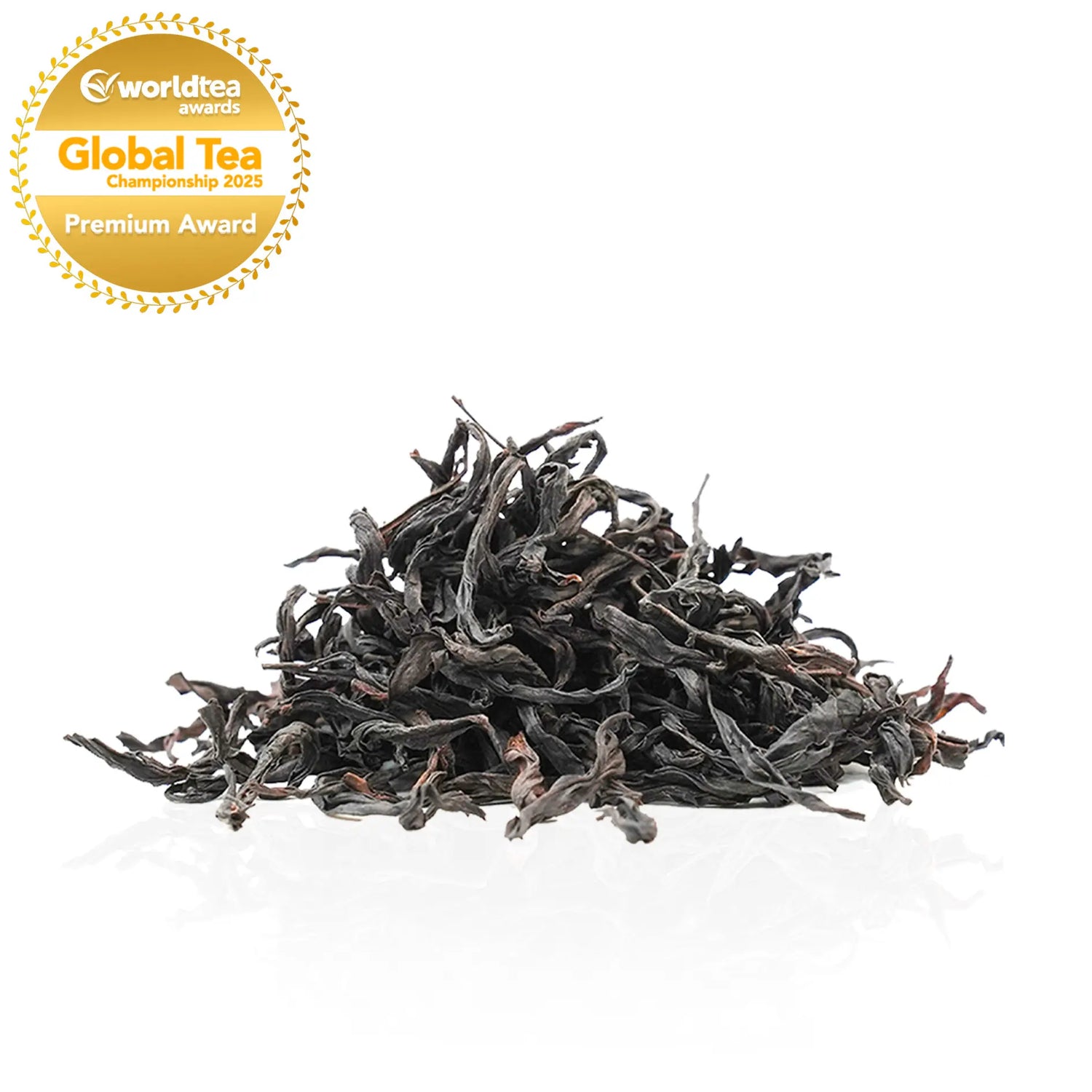
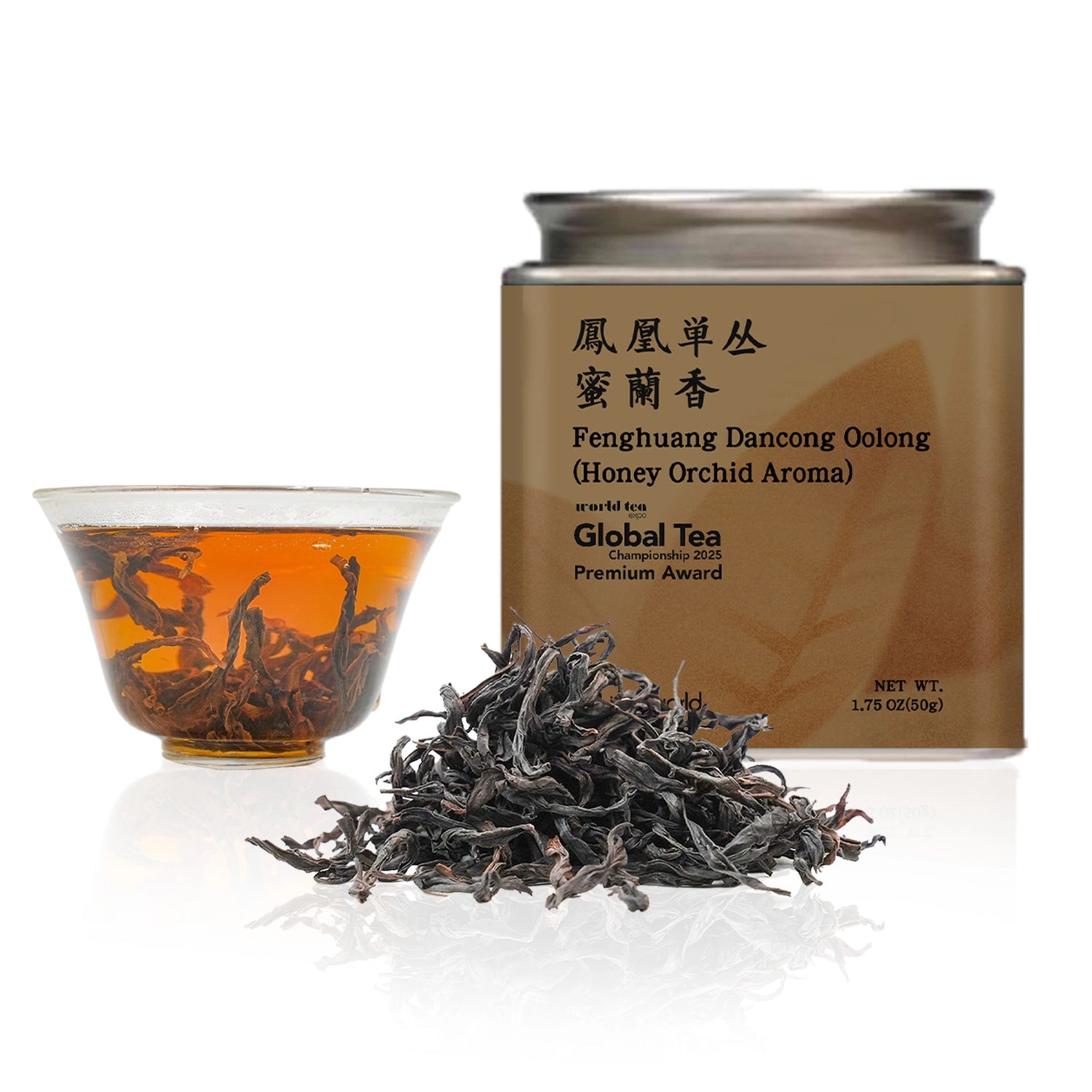
Победитель GTC 2025 — Лучший улун: Iteaworld Mi Lan Xiang Dan Cong 50 г
$99.99 USD
Цена за единицу товара заПобедитель GTC 2025 — Лучший улун: Iteaworld Mi Lan Xiang Dan Cong 50 г
$99.99 USD
Цена за единицу товара заВыдержанное дерево Феникс Данконг - Аромат медовой орхидеи
Победитель Всемирной чайной выставки 2025 года — Лучший чай улун
Ожидаемая отправка около 15-20 апреля.
-
Мастер чая: Чэнь Тяньцзинь (陈添锦)
-
Сорт чая: Медовая орхидея (Ми Лань Сян)
-
Происхождение: деревня Даань, город Фэнхуан, провинция Гуандун — высота 1000 м, основной терруар Феникс Данконг.
-
Возраст дерева: 50-70 лет.
-
Время сбора урожая: май 2024 г.
-
Степень окисления: 35-40%
-
Обжарка: традиционная тройная обжарка на углях
-
1-я обжарка (июнь 2024 г.): 80-90°C
-
2-я обжарка (август 2024 г.): 100–105 °C
-
3-я обжарка (октябрь 2024 г.): 90–100 °C
-
Редкое проявление Феникс Данконг
Этот чай, поставляемый из деревни Даан , одного из самых престижных районов выращивания Феникс Данконг, собирается с древних деревьев возрастом 50-70 лет . Расположенный в горном хребте У Донг (высота 985-1100 м), этот регион имеет 700-летнюю традицию приготовления чая с традиционной обжаркой на древесном угле .
Почему именно древняя древовидная медовая орхидея?
-
Невероятная долговечность: можно заваривать более 15 раз , сохраняя при этом насыщенный вкус.
-
Более насыщенный и сложный аромат: древние деревья поглощают больше питательных веществ , производя чай с интенсивным цветочным ароматом и стойкой сладостью.
-
Более глубокий и полный вкус: более высокое содержание полифенолов и аминокислот создает мягкое, густое ощущение во рту с сильной возвращающейся сладостью.
Традиционная обжарка на древесном угле — выбор настоящего ценителя
В отличие от электрической обжарки, обжарка на угле усиливает аромат и глубину , удаляя горечь и сохраняя уникальные характеристики чая. Этот процесс позволяет листьям поглощать отрицательные ионы и энергию дальней инфракрасной области спектра , создавая более глубокую, сложную обжаренную ноту .
Кроме того, данцун, жареный на углях:
-
Стареет изящно , со временем приобретая более насыщенный вкус.
-
Имеет более низкое содержание влаги , что облегчает хранение
-
Требует многократной обжарки небольшими партиями для обеспечения идеальной консистенции
Результат? Чай, который выглядит потрясающе, имеет богатый вкус, очень ароматный и естественно сладкий — резкий контраст с мягким вкусом и мутным видом чая, обжаренного с помощью электричества .
Коллекция ароматов Fenghuang Dancong 10
Откройте для себя суть китайской чайной культуры Гунфу с этим уникальным набором улун Фэнхуан Даньцун, включающим 10 уникальных натуральных ароматов, таких как жасмин, гардения, медовая орхидея и другие. Эта коллекция, известная как «аромат чая», раскрывает многообразие вкусов, создаваемых различными сортами чайных кустов из города Фэнхуан, центра производства чая Даньцун.
Любите ли вы ароматные чаи, цените гунфу или просто интересуетесь богатым ароматом и вкусом улуна, этот набор подарит вам незабываемое чувственное путешествие. Прекрасно подобранный, он станет идеальным подарком для любителей чая, которые ценят аутентичный, ароматный и высококачественный чай.
Что такое чай Фэнхуан Даньцун?
Чай Фэнхуан Даньцун — это разновидность улуна, выращенного в группе Фэнхуан Шуйсянь. Каждое растение имеет уникальную форму и сорт, образуя отдельную линейку продукции, отсюда и название «Даньцун», что означает «один куст» или «один сорт». Этот чай отличается способностью выдерживать многократные заваривания, крепким послевкусием и насыщенным, стойким ароматом. Благодаря своему неповторимому аромату он считается самым ароматным улуном. В зависимости от ароматических свойств, Фэнхуан Даньцун подразделяется на различные ароматизированные категории.
В состав продукта входят:
Чай Фэнхуан Даньцун Улун (аромат Хуан Чжи) 2*5 г
Чай Фэнхуан Даньцун Улун (аромат орхидеи) 2*5 г
Чай Фэнхуан Даньцун Улун (аромат медовой орхидеи) 2*5 г
Чай Фэнхуан Даньцун Улун (аромат магнолии) 2*5 г
Чай улун Фэнхуан Даньцун (с ароматом цветков имбиря) 2*5 г
Чай Фэнхуан Даньцун Улун (Аромат Османтуса) 2*5 г
Чай Фэнхуан Даньцун Улун (аромат корицы) 2*5 г
Чай Фэнхуан Даньцун Улун (аромат миндаля) 2*5 г
Чай улун Фэнхуан Даньцун (с ароматом ночи) 2*5 г
Чай Фэнхуан Даньцун Улун (аромат жасмина) 2*5 г
Источник:
Город Фэнхуан, город Чаочжоу, провинция Гуандун.
Знакомство с 10 лучшими ароматами чая Фэнхуан Даньцун
Чай улун Фэнхуан Даньцун (аромат Хуан Чжи) : высококачественный однокустовый чай с натуральным ароматом гардении.
Чай улун Фэнхуан Даньцун (с ароматом орхидеи) : обладает ароматом орхидеи, свежим и тонким.
Чай улун Фэнхуан Даньцун (с ароматом медовой орхидеи) : самый популярный сорт, известный своим насыщенным медовым вкусом в сочетании с ароматом орхидеи, отсюда и название «Милан».
Чай улун Фэнхуан Даньцун (с ароматом магнолии) : свежий и элегантный, с ароматом цветов магнолии.
Чай улун Фэнхуан Даньцун (с ароматом цветков имбиря) : также известен как «Проникающий небесный аромат», так назван из-за бодрящего аромата цветков имбиря при заваривании чая.
Чай улун Фэнхуан Даньцун (с ароматом османтуса) : напоминает цветы османтуса, сладкий и стойкий.
Чай Фэнхуан Даньцун Улун (с ароматом корицы) : назван в честь вкуса чая, напоминающего вкус корицы, традиционного китайского лекарственного средства.
Чай улун Фэнхуан Даньцун ( с ароматом миндаля) : также известен как «Пилообразный», названный так из-за зазубренных краев листьев и ярко выраженного аромата миндаля.
Чай улун Фэнхуан Даньцун (с ароматом ночи) : Даньцун с ароматом ночи славится своим уникальным вечерним ароматом и вкусом. Он производится в основном на озере Фэнси-Дань в городе Фэнхуан и довольно редок.
Чай улун Фэнхуан Даньцун (с ароматом жасмина) : уникальный аромат с ароматом цветов жасмина, освежающий и восхитительный.
Советы по завариванию пива
Рекомендуемый метод: традиционный стиль Гунфу.
Лучшая чайная посуда: белая фарфоровая гайвань или чайник из исинской глины.
Соотношение чая и воды: используйте 5 г чая на 100 мл воды.
Температура воды: 212℉ (100℃).
Время заваривания:
Первое ополаскивание: быстро слейте воду и вылейте ополаскиватель.
2–5-й заваривания: настаивать 6–8 секунд.
6–10-й заваривания: настаивать 10–15 секунд.
Долговечность заваривания: настоящий Даньцун из региона Фэнхуан города Чаочжоу можно заваривать 12–15 раз.
Техника приготовления: лейте воду по краю гайвани тонкой струйкой. Слегка наклоните крышку, оставив небольшой зазор, чтобы избежать чрезмерного испарения.
Чтобы исследовать, как выдержка меняет вкус чая, мы выбрали пять чаев Миньнань Шуйсянь, обжаренных по традиционной технологии на углях, от зарубежной китайской чайной фабрики Yongchun Beikeng — урожая 1994, 2004, 2014, 2020 и 2024 годов.
Это дегустационное путешествие покажет, как время преображает богатый характер улуна Шуйсянь. Давайте вместе прочувствуем эту эволюцию.
В этот набор входит:
Чай Миньнань Шуйсянь 2024 года (обжаренный на углях, с насыщенным ароматом)* 20 г
Миньнань Шуйсянь 2019 года (обжаренный на углях, с насыщенным ароматом)* 20 г
Миньнань Шуйсянь 2014 года (обжаренный на углях, с насыщенным ароматом)* 20 г
Миньнань Шуйсянь 2004 года (обжаренный на углях, с насыщенным ароматом)* 20 г
1994 Minnan Shui Xian (обжаренный на углях, с насыщенным ароматом)* 20 г
Эволюция вкуса (для справки)
2024 (Новый Чай):
В чае доминирует натуральный аромат орхидеи с нотками обжаренных на углях нот. Аромат яркий и стойкий — при заваривании кипящей водой поднимающийся пар приобретает насыщенную цветочную ноту. Чай оставляет в чашке чистый, стойкий аромат. Вкус насыщенный, мягкий и сладкий, с богатым, но без горечи, послевкусием. Он обеспечивает выраженную, возвращающуюся сладость и долгое, стойкое послевкусие. Настой крепкий, но не слишком бодрящий.
5-летний (2020):
Аромат орхидеи угасает, угольные ноты отступают. Начинают проявляться нотки спелых фруктов и лёгкий оттенок свежей древесины. Появляется лёгкая кислинка, но чай всё ещё стимулирует слюноотделение. Общий вкус становится более мягким, хотя и немного тоньше по сложности.
10-летний (2015):
Кислотность уменьшается. Выдержанные ноты (например, сухое дерево) смешиваются с лёгкими оттенками орхидеи. Свежесть исчезает. Ликер становится шелковистым, а возвращающаяся сладость сменяется мягкостью, напоминающей каменно-сахарный вкус.
20-летний (2005):
В аромате доминируют выдержанные ноты (сандал, травы). Напиток приобретает янтарный цвет, становится густым и насыщенным, как рисовый суп. Послевкусие глубокое, с лекарственными оттенками.
30 лет (1995):
Сложное сочетание выдержанных и травяных нот (например, женьшеня и сушеной цитрусовой цедры). Напиток густой, мягкий и почти маслянистый. Сладость тонкая и изысканная, с длительным послевкусием, напоминающим выдержанный напиток.
Как заваривать?
Чайная посуда:
Для заваривания свежего чая используйте гайвань или исинский чайник.
Для чая, выдержанного 5–10 лет, используйте исинский чайник.
Для заваривания чая, выдержанного 20 лет и более, используйте старый исинский чайник или грубый глиняный горшок.
Температура воды:
Свежий чай: 95–100°C
Выдержанный чай: 100°C
Соотношение чая и воды:
1 г чая на 20 мл воды
Пробуждение чая:
Для чая, выдержанного 5–10 лет: откройте пакетик и дайте чаю подышать около 5 минут перед завариванием.
Для чая, выдержанного 20+ лет: откройте пакет и дайте ему проветриться за день.
Крутое время
Сначала промыть:
Первый заваривание: быстрое 3-секундное ополаскивание, сливаем — это нужно для того, чтобы чай прогрелся и пробудился.
2–4-е заваривание: 8–15 секунд
Начиная с 5-го заваривания: увеличивайте время на 5–10 секунд на каждую заварку.
Для выдержанного чая (20+ лет):
Можно заваривать непосредственно перед употреблением или заваривать в чайнике 10 раз перед кипячением.
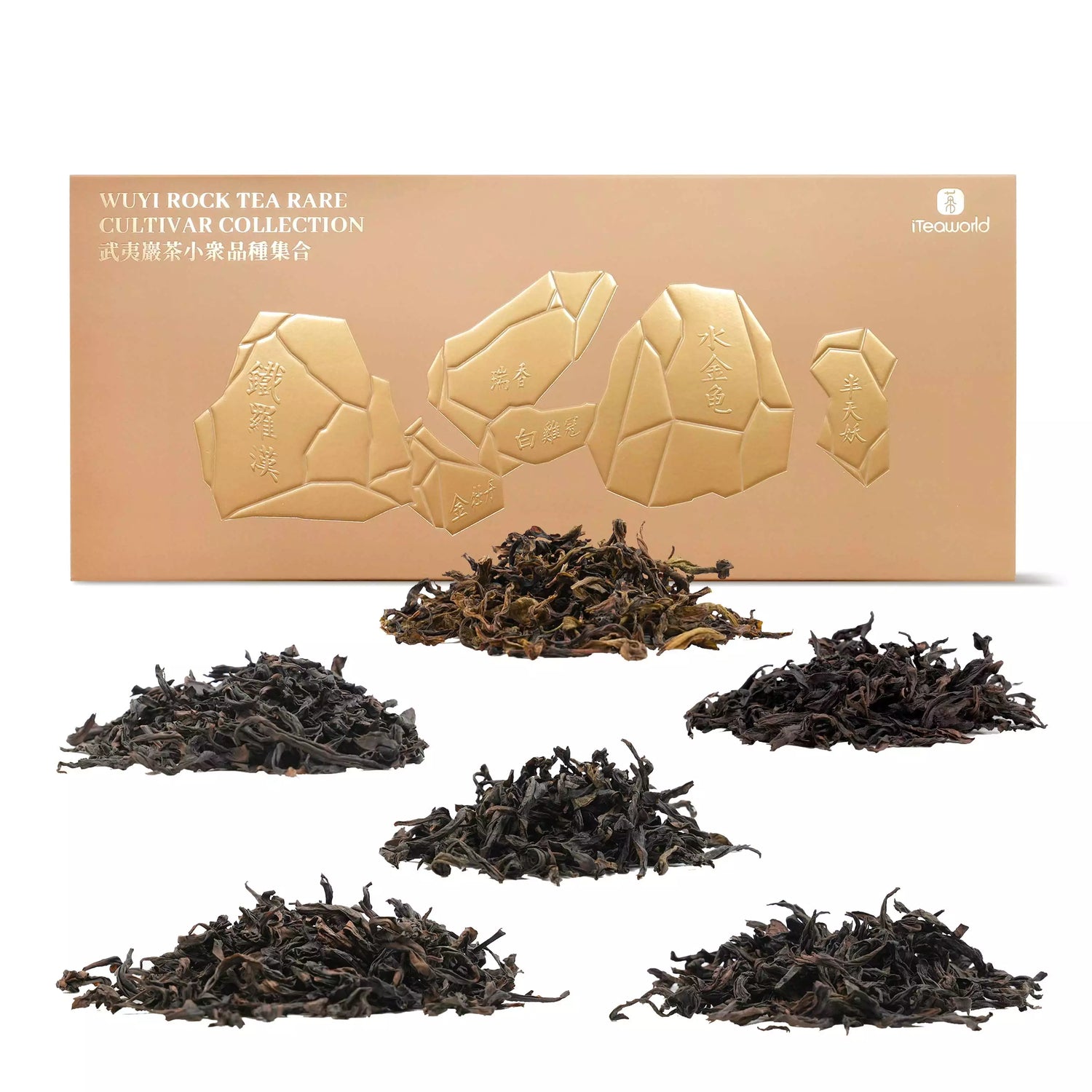

Коллекция редких сортов чая с утеса Уи — наследие и инновации, 100 г
$52.99 USD
Цена за единицу товара заКоллекция редких сортов чая с утеса Уи — наследие и инновации, 100 г
$52.99 USD
Цена за единицу товара за Кому понравится этот чай?
Эта коллекция идеально подходит тем, кто знаком с классическими чаями из Уи и готов глубже погрузиться в их редкие и самобытные сорта. В неё входят такие известные сорта, как Те Лохань, Бань Тянь Яо, Бай Цзи Гуань, Шуй Цзинь Гуй и Бай Жуй Сян, а также новые, пользующиеся большим спросом сорта, такие как Жуй Сян и Цзинь Мудань. Путешествие по многообразию вкусов и мастерству приготовления чая из Уи.
Состав продукта:
Те Луохань (Железный Архат)* 3 пакетика* 5 г
Бай Цзигуан (белый петушиный гребень)* 3 пакетика* 5 г
Шуй Цзинь Гуй (Золотая Водяная Черепаха)* 4 пакетика* 5 г
Бантиан Яо (Полунебесный гоблин)* 3 пакетика* 5 г
Джин Мудан (Золотой Пион)* 4 пакетика* 5 г
Байжуйсян (орхидея со ста ароматами) * 3 пакетика* 5 г
Чайный мастер: Чэнь Хуэй陈辉
Происхождение: деревня Цзиншуй, город Синцунь, город Уишань, провинция Фуцзянь.
Время обработки: ноябрь 2024 г.
Срок годности: 36 месяцев
Высота: 400-600 метров
Почва: Гравийная почва
Окисление: 45-55%
Степень обжарки: средняя
Способ обжарки: обжарка на древесных углях
Редкие сорта чая с горы Уишань: скрытые жемчужины из самого сердца Чжэнъяня
В то время как такие чаи, как Да Хун Пао, Жоу Гуй и Шуй Сянь, стали известными представителями чая из Уи, редкие сорта, такие как Те Ло Хань, Бай Цзи Гуань, Шуй Цзинь Гуй и Бань Тянь Яо, рассказывают более глубокую и аутентичную историю. Эти чаи происходят от диких, старинных чайных деревьев, которые веками росли в самом сердце гор Уи, и формировались естественным отбором и бережным выращиванием. Они воплощают в себе изначальное генетическое наследие чая из Уи.
Эти чайные деревья, произрастающие на отдалённых скалах и обрывистых уступах в основной зоне производства Чжэнъянь, таких как пещера Гуйдун и пик Саньхуа, глубоко пускают корни в расщелины скал, впитывая редкие минералы. В результате получается неповторимый вкусовой профиль с неуловимым и неповторимым «Янь Юнь» (стихотворение скалы), который ценят ценители.
Каждый редкий сорт дарит уникальные вкусовые ощущения:
«Бай Цзи Гуань» обладает легким, сладким ароматом кукурузных рылец.
В аромате Tie Luo Han ощущаются согревающие травяные ноты, напоминающие корень дягиля.
Ban Tian Yao поражает экзотическим букетом гардении, молока и меда — сложным и незабываемым.
Их редкость лишь добавляет им загадочности. Например, Бань Тянь Яо даёт менее 100 фунтов урожая в год. Тем не менее, несмотря на низкую урожайность, эти сорта имеют преданных поклонников среди опытных ценителей чая и коллекционеров. Один из самых выдающихся сортов, Жуй Сян, ценится как «секретное оружие» в премиальных купажах за свой пронзительный, стойкий аромат.
Эти чаи — не просто вкус, они — живое культурное наследие.
Бай Цзи Гуань имеет даосские корни.
Сюжет «Шуй Цзинь Гуй» связан с легендами о золотой черепахе, ищущей справедливости.
Когда-то «Те Ло Хань» был ведущим экспортным товаром в Юго-Восточную Азию.
В эпоху массового производства и стандартизации вкуса эти редкие сорта чая из Уи предлагают смелую альтернативу: многогранность, характер и глубокая связь с терруаром. Их устойчивость к болезням, способность расти в тени и засухе, также открывает перспективы для будущего чайного дела.
Как говорят местные чаеводы: «Жоу Гуй олицетворяет сегодняшний день, но редкие сорта ведут нас в завтрашний день». Знакомство с ними — словно чтение живой энциклопедии чая с утеса Уи: каждый глоток — это страница из архива самой природы.
Как заваривать эти чаи?
-
Основные принципы
Чайная посуда: используйте фарфоровую гайвань (лучше для аромата) или чайник из исинской глины (для усиления насыщенности чая).
Вода: Фильтрованная или родниковая (избегайте жёсткой воды). Температура: Кипение (100°C/212°F) для чая средней/сильной обжарки; 90–95°C (194–203°F) для чая слабой обжарки.
Соотношение: 1:20 чая и воды (например, 5 г/3,8 унции чая на 110 мл/3,8 унции воды). -
Этапы заваривания
Подогрейте чайную посуду: ополосните чашки и чайник горячей водой, чтобы раскрыть ароматы.
Первое полоскание: Залейте листья кипятком и сразу же выбросьте (это пробудит чай).
Заваривание:
Короткие заваривания: начните с 5–10 секунд для первых трех завариваний.
Постепенно увеличивайте время: добавляйте 5–10 секунд на каждое последующее заваривание.
Избегайте чрезмерного настаивания: это предотвращает появление горечи.
Советы для западных людей
Подсказки по вкусу:
«Rock Essence» (Янь Юнь): минеральное послевкусие, напоминающее влажные камни, — признак качества.
Тест на холодную чашку: понюхайте пустую чашку после глотка. Настоящий уишанский чай сохраняет ноты альпийских трав и сливы.
Устранение горечи: сократите время заваривания или используйте более прохладную воду (88–90 °C).
Сочетания: Темный шоколад (для блюд сильной обжарки) или лимонный тарт (для блюд слабой обжарки).

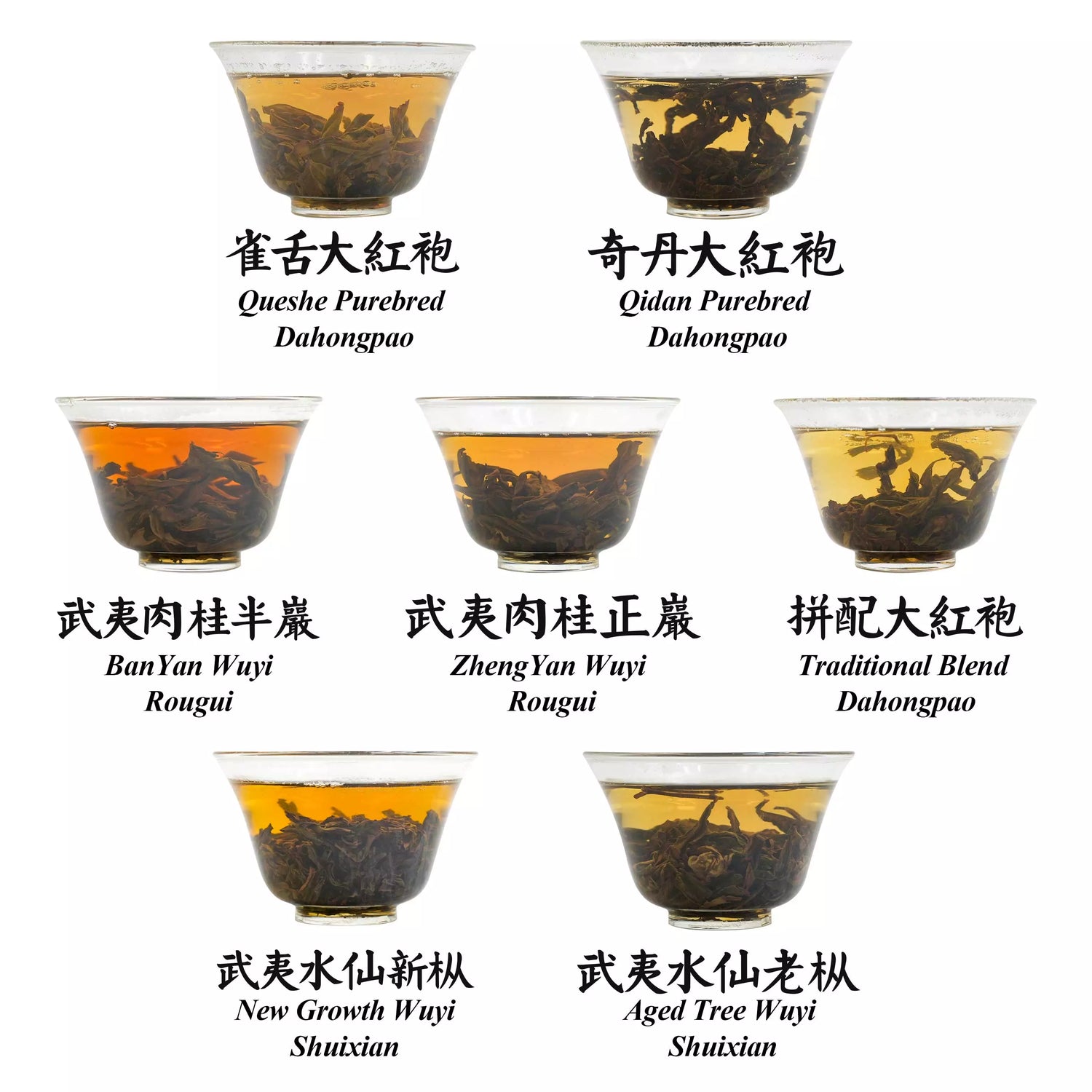
Коллекция чая «Mainstream Wuyi Rock» — 7 сравнений вкусов, 100 г
$74.99 USD
Цена за единицу товара заКоллекция чая «Mainstream Wuyi Rock» — 7 сравнений вкусов, 100 г
$74.99 USD
Цена за единицу товара заПолуферментированный улун, выращенный в скалистых расщелинах горы Уи в провинции Фуцзянь, известный своим уникальным ароматом «цветов каменной косточки» (Янь Юнь). Только чай, выращенный в охраняемой зоне города Уи, может носить это название. В других регионах (например, в Аньси) каменный чай не выращивают.
В этой коллекции представлены три самых культовых чая из Уи — да Хун Пао, Шуйсянь и Жужуй — а также их основные разновидности. Вы почувствуете разницу между купажированным и чистосортным Да Хун Пао, молодыми и старыми деревьями Шуйсянь, а также сердцевиной и полусердцевиной Жужуй. Вас ждет увлекательное путешествие в глубину и многогранность чая из Уи.
Как начать пить чай из утеса Уишань?
Новичкам мы рекомендуем начать с купажированных чаев Да Хун Пао, Шуйсянь и Жугуй — классических, доступных и хорошо сбалансированных чаев, которые станут прекрасным введением в чай Ушань.
Купажированный Да Хун Пао – самый знаменитый чай из Уишаньского утеса, купажированный для гармоничного вкуса с минеральностью утеса, цветочно-фруктовыми нотками и глубоким ароматом обжарки. Идеальный выбор для новичков.
Шуйсянь – мягкий и сочный, с древесной сладостью и длительным послевкусием. Идеально подходит для тех, кто предпочитает насыщенную, округлую текстуру.
Rougui – пряный аромат корицы с ярким, согревающим характером. Отличный выбор для любителей экспериментировать.
Почему стоит начать с этого?
Легко найти – широко распространены и отличаются стабильным качеством.
Доступная цена – отличное соотношение цены и качества за настоящий чай из утеса Уишань.
Универсальный – Охватывает основные вкусовые характеристики «Янь Юнь» (эссенции горных пород).
Состав продукта:
Традиционная смесь Дахунпао* 3 пакетика* 5 г
Qidan Purebred Dahongpao*3 пакетика* 5 г
Queshe Purebred Dahongpao* 3 пакетика* 5 г
Новый урожай Уи Шуйсянь* 3 пакетика* 5 г
Выдержанное дерево Уи Шуйсянь*3 пакетика* 5 г
BanYan Wuyi Rougui* 3 пакетика* 5 г
ZhengYan Wuyi Rougui* 2 пакетика* 5 г
Чайный мастер: Чэнь Хуэй陈辉
Происхождение: деревня Цзиншуй, город Синцунь, город Уишань, провинция Фуцзянь.
Время обработки: ноябрь 2024 г.
Срок годности: 36 месяцев
Высота: 400-600 метров
Почва: Гравийная почва
Окисление: 45-55%
Степень обжарки: средняя
Способ обжарки: обжарка на древесных углях
Как заваривать чай из скалы Уишань?
Вода: используйте фильтрованную или родниковую воду (избегайте жесткой воды).
Чайная посуда: чайник из исинской глины для чая средней и высокой обжарки; фарфоровая гайвань для чая более слабой обжарки.
Пробуждение: Выдержанный чай: сухая заварка в течение 1 часа; молодой чай: по желанию.
Температура: 95–100°C (203–212°F).
Соотношение чая и воды: 5 г на 90–100 мл (1:20).
Заваривание: Первые 3 заваривания: 5–10 сек., затем увеличить на 5–10 сек. Всего 8–10 завариваний.
Выдержанный Шуйсянь: первое заваривание 20 секунд для усиления аромата.
Советы:
Слабая обжарка (Цюэ Шэ, новый Шуйсянь): избегайте длительного нагревания.
Полная обжарка (Бэйдоу, выдержанный чай): для активизации ароматов используйте кипяток.
Кипящая вода для крепких сортов чая (Жоу Гуй, Бэйдоу): более низкая температура для деликатных сортов чая (Цюэ Шэ, новый Шуйсянь).

Набор для сравнения обжарки улуна: угольная и электрическая, 80 г, предпродажа
$34.99 USD
Цена за единицу товара заНабор для сравнения обжарки улуна: угольная и электрическая, 80 г, предпродажа
$34.99 USD
Цена за единицу товара за Этот продукт находится в стадии предварительной продажи и, как ожидается, поступит в продажу в августе.
Пожалуйста, обратите внимание перед оформлением заказа.
Путешествие огня и технологий
«Веками китайские мастера улуна спорили: медленный танец угля или точность электрического нагрева? Этот набор предлагает вам исследовать две философии обжарки на примере чая Phoenix Dancong и Wuyi Rock — одна из них основана на мудрости предков, другая усовершенствована технологиями».
Состав продукта:
Уи Ругуи, обжаренные на углях* 20 г
Электрическая жарка Уи Руги* 20 г
Жареный на углях Ми Лан Сян Даньцун* 20 г
Electric-Roasted Mi Lan Xiang Dancong* 20 г
Информация о продукте (Уи Ругуй)
Тип: Полукамень (Бань Янь)
Происхождение: деревня Цзиншуй, город Синцунь, город Уишань, провинция Фуцзянь, Китай.
Высота: 400 м
Продюсер: Чэнь Хуэй
Сроки обработки: Маоча: апрель 2024 г.; Первичная обжарка: август 2024 г.; Окончательная обжарка: ноябрь 2024 г.
Информация о продукте (Ми Лан Сян Даньцун)
Происхождение: деревня Фэнси, город Фэнхуан, город Чаочжоу, провинция Гуандун, Китай.
Высота: 600–800 м
Возраст дерева: ~30 лет
Продюсер: Линь Чжицян
Сроки обработки: Маоча: апрель 2024 г.; Первичная обжарка: август 2024 г.; Окончательная обжарка: ноябрь 2024 г.
Обжарка на древесном угле: искусство традиционного улуна
Обжарка на древесном угле — это душа традиционного улуна. Медленная, слабая обжарка на древесном огне, например, на лонгане или личи, преображает листья, создавая насыщенный вкусовой профиль с карамельной сладостью, минеральными нотками и дымной глубиной.
Этот метод идеально подходит для чая Wuyi Rock и Phoenix Dancong, поскольку он превращает травянистые ноты в мягкие, сложные профили и подчеркивает карамельную и фруктовую сладость.
По сравнению с современной электрической обжаркой обжарка на древесном угле обеспечивает:
Лучшая текстура — глянцевые темно-коричневые листья вместо зеленовато-коричневых
Более насыщенные ароматы — дымные и натуральные ароматы чая вместо одного жареного вкуса
Больше заварок — более 8 вместо 5
Более длительный срок хранения — продукт сохраняется более 5 лет, в отличие от продукта, который нужно употребить в течение года.
Несмотря на такие проблемы, как высокие выбросы углерода, обжарка на углях необходима для элитных улунов, подобно тому, как дубовые бочки нужны для изысканного вина. Она превращает чай из «свежих листьев» в живое, развивающееся искусство.
Электрическая обжарка: современный подход к улунскому чаю
Электрическая обжарка — ключевой метод современного производства улуна, обеспечивающий значительные преимущества в эффективности и стабильности качества. С помощью электрических нагревательных элементов температура точно контролируется в диапазоне от 70 до 130 °C, а время обжарки обычно составляет от 2 до 5 часов. Этот процесс повышает скорость производства по сравнению с традиционной обжаркой на древесном угле.
Одной из отличительных особенностей электрической обжарки является цифровая регулировка температуры, поддерживающая её в пределах ±5 °C. Это устраняет неравномерные колебания температуры, характерные для обжарки на древесном угле, что делает её идеальным решением для улунов лёгкой ферментации, сохраняющих свежие цветочные и фруктовые ароматы.
Чай, обжаренный на электрической сковороде, обладает яркими цветочными нотками и освежающим вкусом. Цвет чая прозрачный и яркий. Хотя ему не хватает насыщенного вкуса чая, обжаренного на древесном угле, он отвечает требованиям современных потребителей к лёгкому, освежающему чаю.
Как заваривать?
Чайная посуда: исинский чайник (предпочтительно из глины чжуни) или толстостенная гайвань.
Качество воды: родниковая или мягкая вода (жесткость < 50 мг/л)
Соотношение чая и воды: 5 г чая / 100 мл воды
Температура воды: 100°C (кипящая)
Промывание: быстро промыть кипящей водой (менее 5 секунд); вылить первую настойку.
Время заваривания:
Инфузии 1–3: по 15 секунд каждая
Настои 4–10: Ми Лань Сян: увеличивать на 5 секунд на каждый настой
Уи Ругуй: увеличивайте время на 5–10 секунд на каждую заварку
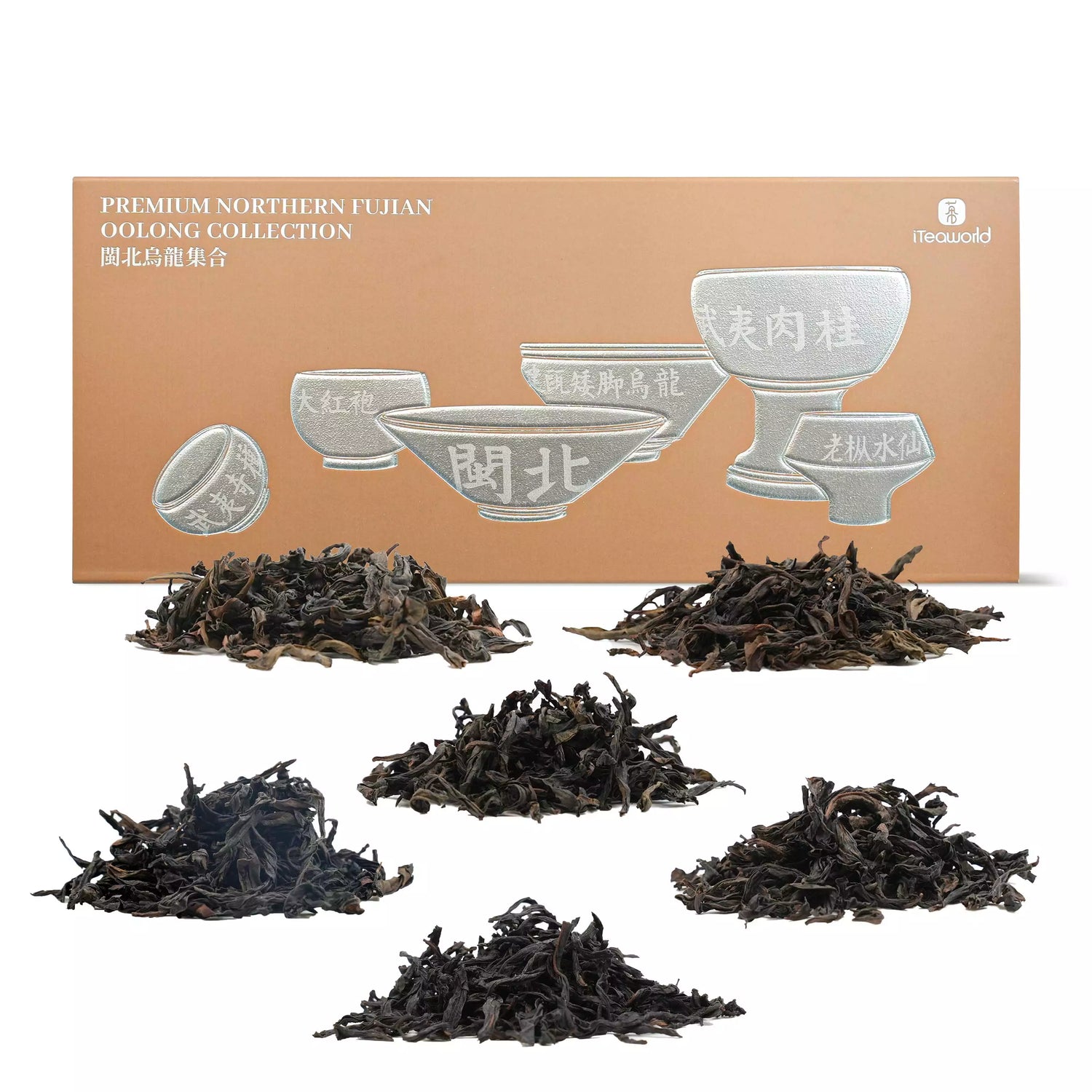
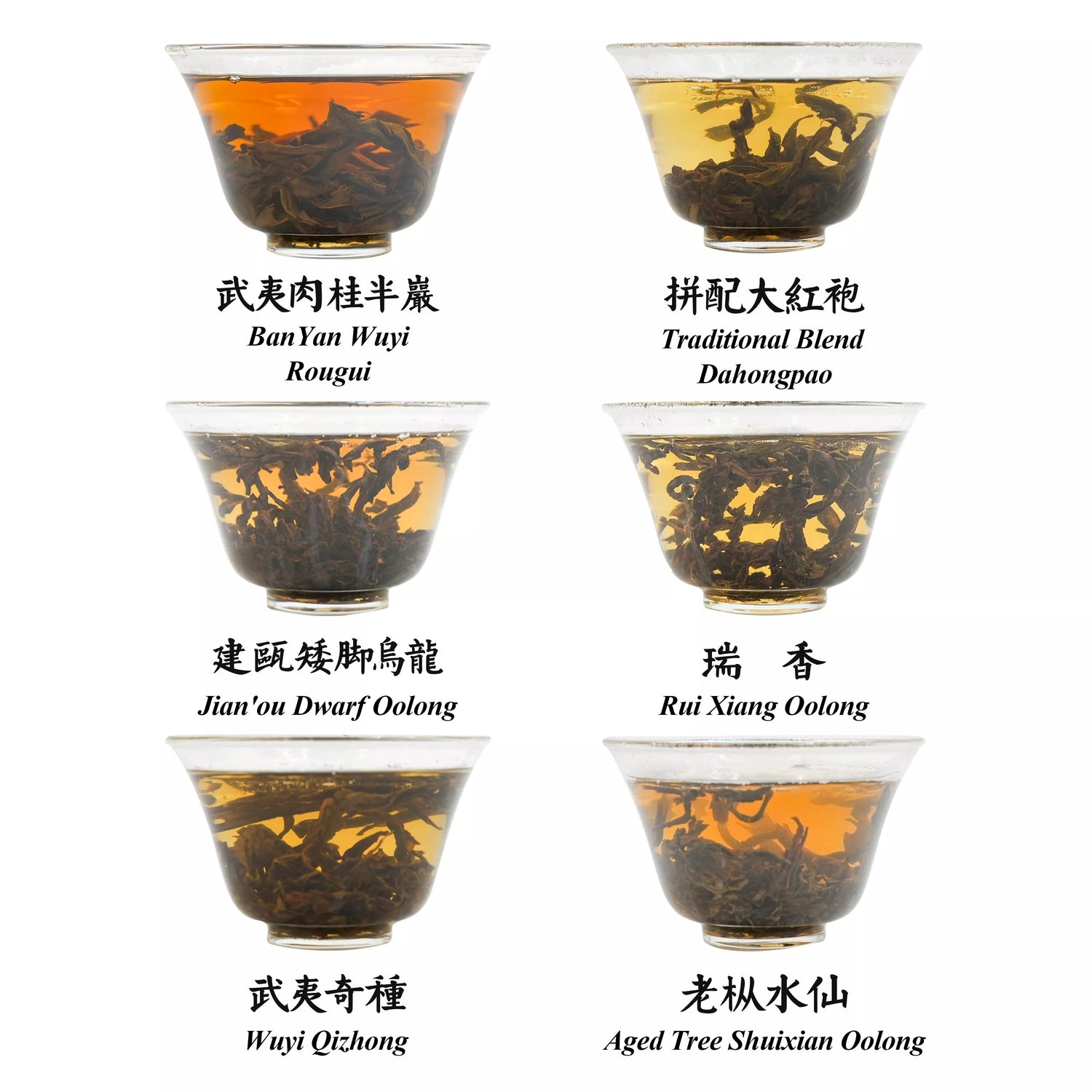
Коллекция улунов Северной Фуцзянь — 6 представительных вкусов 100 г
$39.99 USD
Цена за единицу товара заКоллекция улунов Северной Фуцзянь — 6 представительных вкусов 100 г
$39.99 USD
Цена за единицу товара заСеверный Фуцзянь считается родиной улуна, а традиционные методы производства чая Wuyi Rock Tea признаны частью нематериального культурного наследия Китая. Эта коллекция включает в себя культовые сорта улунов от династии Сун (Уи Цичжун и улун Цзяньоу Карликовый) до наших дней (Блендированный Да Хун Пао, Уи Жугуй, Улун Шуйсянь Выдержанного Дерева), а также новые сорта с большим потенциалом (Улун Жуйсянь). Каждый чай несет в себе уникальное мастерство региона, свою неповторимую историю и вкус. Мы надеемся, что эта коллекция позволит вам открыть для себя разнообразие вкусов и богатое культурное наследие улуна из Северной Фуцзянь (Миньнань).
Состав продукта:
Уи Цичжун*3 пакетика* 5г
Карликовый улун Цзяньоу*3 пакетика* 5 г
Смесь Да Хун Пао*4 пакетика* 5 г
Уи Руги *4 пакетика* 5г
Выдержанный чай Шуйсянь улун*3 пакетика* 5 г
Улун Руй Сян*3 пакетика* 5 г
Время обработки: ноябрь 2024 г.
Срок годности: 36 месяцев
Чай улун из Миннаня: чашка, история, предание
1. Происхождение (династии Тан и Сун)
- Для производства чая «бэйюань» (разновидности пропаренного зелёного чая) местные жители использовали чай «Уи цайча» (Qi zhong) . Во время транспортировки листья соприкасались, в результате чего некоторые из них краснели и подвергались частичному окислению, приобретая полуферментированные свойства, которые считаются истоками чая «улун».
2. Рождение (династия Мин)
- После того как император Чжу Юаньчжан запретил прессованные чайные лепешки, фермеры-чаеводы горы Уи объединили методы обработки зеленого и черного чая, чтобы создать полуферментированный улун.
3. Развитие (династия Цин)
- Чай Уи-Цай (Ци Чжун): к эпохе династии Цин, чай Уи-Цай (Wuyi Rock Tea) разработал основные методы сушки на солнце, встряхивания и обжаривания. Система чая Уи-Цай достигла зрелости, и первыми представителями этого чая стали чай Уи-Цай (Ци Чжун) и четыре его известных сорта (Да Хун Пао, Бай Цзи Гуань, Те Ло Хань, Шуй Цзинь Гуй).
- Карликовый улун Цзяньоу: Карликовый улун (также известный как улун Сяо Е) родом из города Дунфэн Цзяньоу был завезен на гору Уи, где его усовершенствовали с помощью мастерства, включая обжарку на древесном угле, что придало ему характерный персиковый аромат и выраженный минеральный привкус, что сделало его фаворитом для купажирования и дало ему прозвище «Премьер-министр чая».
- Уи-жуй: Жоу-гуй, ещё один знаменитый горный чай, берёт своё начало в эпоху династии Цин. Когда-то он был редким и встречался лишь в скалистых районах Уи, но в 1960-х годах его ареал значительно расширился благодаря вырубке и размножению.
- Уи Шуйсянь: Чай Шуйсянь, завезенный из Цзяньяна в 1800-х годах, стал классикой провинции Фуцзянь благодаря своему насыщенному древесному вкусу и плотной текстуре.
4. Процветание (с XX века по настоящее время)
- Смешанный Да Хун Пао: В XX веке прорыв в методах бесполого размножения позволил успешно размножить Да Хун Пао путем черенкования в 1982 году, что привело к массовому производству чистого Да Хун Пао после того, как в 2006 году прекратился сбор урожая с материнского дерева.
- Жуйсян: Новые гибридные сорта, такие как Цзинь Мудань, Хуан Гуаньинь и Жуйсян, были выведены путём скрещивания традиционных сортов, таких как Жоу Гуй, Шуй Сянь и Хуан Цзинь Гуй. Жуйсян, в частности, известен своим постоянно меняющимся ароматом — от ладана и гардении до османтуса, персика и мёда, — за что получил прозвище «Изменитель облика» среди горных чаёв.
Уникальные характеристики крафта:
1. Интенсивная ферментация и окисление
Северофуцзяньские улуны обрабатываются по уникальной технологии: более длительное завяливание на солнце, лёгкое, но многократное встряхивание, несколько циклов окисления и глубокая ферментация. По сравнению с южнофуцзяньскими улунами (которые окислены на 10–30%), северофуцзяньские улуны имеют степень окисления от 25 до 55%, что придаёт чаю насыщенный янтарно-золотистый цвет и более мягкий, насыщенный вкус.
2. Процесс обжарки древесного угля
Обжарка на древесном угле — фирменная техника производства улунских чаёв Северной Фуцзянь. Она включает три ключевых этапа:
Первичная обжарка («Water Walk»): высокая температура (~150 °C) используется для быстрого удаления поверхностной влаги и травянистых ноток.
Вторая обжарка (медленная обжарка): щадящая, продолжительная обжарка, длящаяся 10–18 часов, с постепенным понижением температуры до ~80 °C. На этом этапе раскрываются насыщенные карамельные и минеральные ноты.
Финальная обжарка (выдержка): очень медленная обжарка при температуре 60–80 °C в течение 12–24 часов. Этот этап снижает влажность листа до 3–5%, увеличивая срок хранения и потенциал выдержки.
Для обеспечения равномерной обжарки используется только плотный уголь из твердых пород древесины, например, лонгана или личи.
Этот традиционный метод придает чаю теплый, округлый вкус с глубоким ароматом обжарки, более мягкий и изысканный характер, чем резкий вкус чая, обжаренного с помощью электрочайника.
3. Раскатка и формовка
Никакого скручивания — в отличие от южнофуцзяньских улунов, северофуцзяньские улуны не скручиваются плотно, сохраняя свою длинную, скрученную форму листа с глянцевым темным оттенком и красновато-коричневыми бликами.
Двойная обжарка и скручивание — чай обжаривается и скручивается дважды, что обеспечивает равномерное высвобождение его внутренней эссенции и создание более густого, шелковистого чайного настоя.
Рекомендации по завариванию:
Чайная посуда:
Гайвань (110–150 мл): лучше всего подходит для ароматных чаев (Руги, Данги).
Чайник из исинской глины: идеально подходит для сильно обжаренных или выдержанных чаев.
Вода:
Используйте родниковую или очищенную воду температурой 100°C (кипящую).
Соотношение чая и воды:
5 г чая / 110 мл воды.
Советы по завариванию:
Разогрейте и пробудите чай.
Высокий уровень налива для аромата, низкий уровень налива для мягкости.
Первые 3 проливайте быстро (5–10 с), затем увеличьте время настаивания.
Полностью сливайте воду после каждой варки.
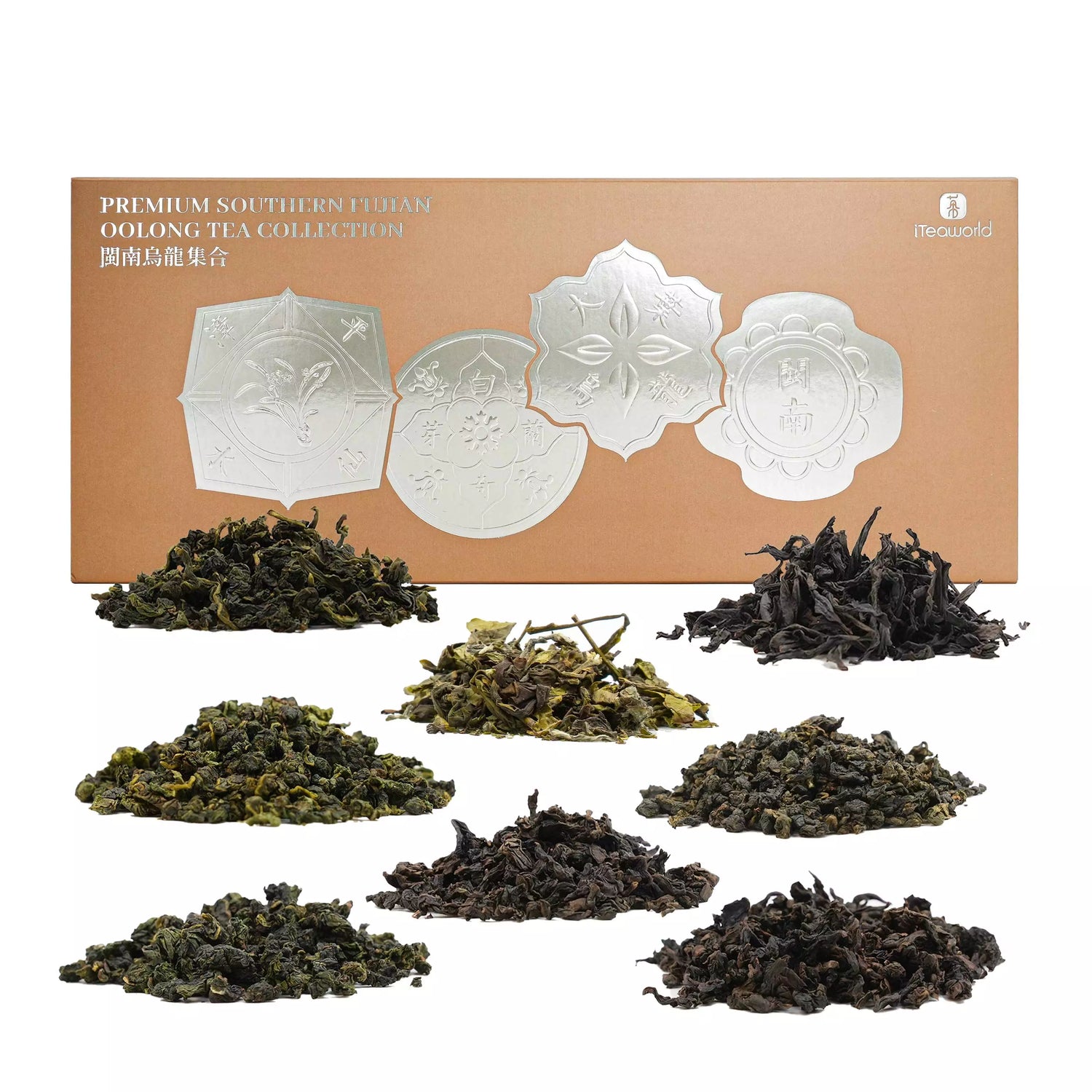
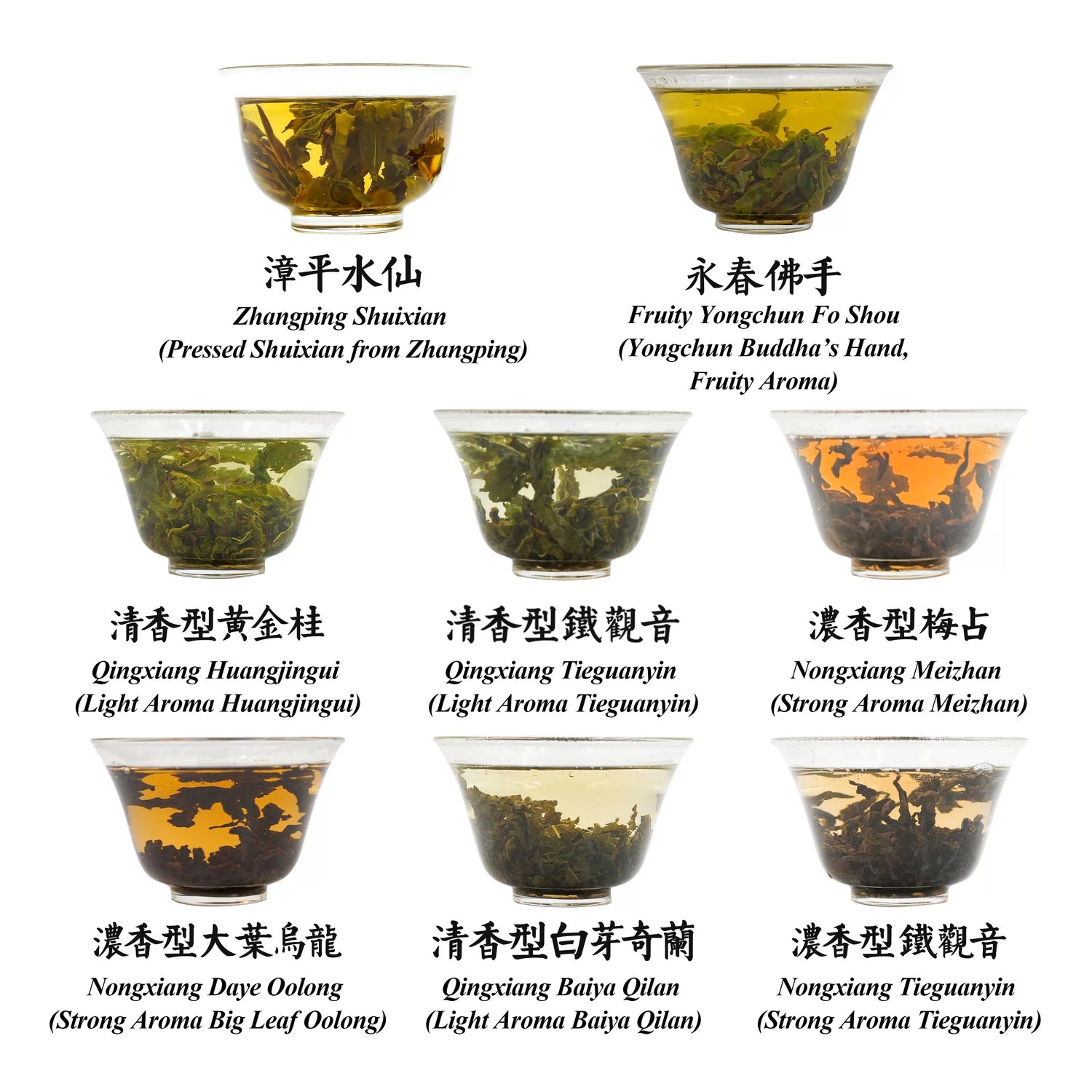
Коллекция улунов «Южная Фуцзянь» — 8 уникальных исторических вкусов 100 г
$29.99 USD
Цена за единицу товара заКоллекция улунов «Южная Фуцзянь» — 8 уникальных исторических вкусов 100 г
$29.99 USD
Цена за единицу товара заОткройте для себя богатое наследие южнофуцзяньских улунских чаёв — родины культовых Те Гуань Инь и Чжанпин Шуй Сянь, признанных частью нематериального культурного наследия Китая. С XVII века этот регион является пионером в производстве ароматных улунов, известных своими цветочными, фруктовыми нотами и лёгкой обжаркой. Эти чаи, изготовленные с использованием проверенных временем техник, таких как лёгкое окисление, многослойная обжарка и кропотливая формовка листьев, отражают суть миннаньской традиции. Независимо от того, являетесь ли вы опытным любителем чая или только начинаете свой путь, эта тщательно подобранная коллекция предлагает вам истинный вкус истории улунов.


Коллекция чая Гуандун Улун: 6 исторических вкусов для любителей чая, 100 г
$49.99 USD
Цена за единицу товара заКоллекция чая Гуандун Улун: 6 исторических вкусов для любителей чая, 100 г
$49.99 USD
Цена за единицу товара за Путешествие в суть гуандунского улуна в коробке
От древнего улуна Шигупин, созданного народностью Шэ более 1500 лет назад, до современных ароматных чаёв Даньцун, этот тщательно отобранный набор включает шесть фирменных чаёв из Чаочжоу, Мэйчжоу и Жаопина — трёх основных регионов провинции Гуандун. Насладитесь ароматным путешествием по 500-летнему наследию чайного искусства.
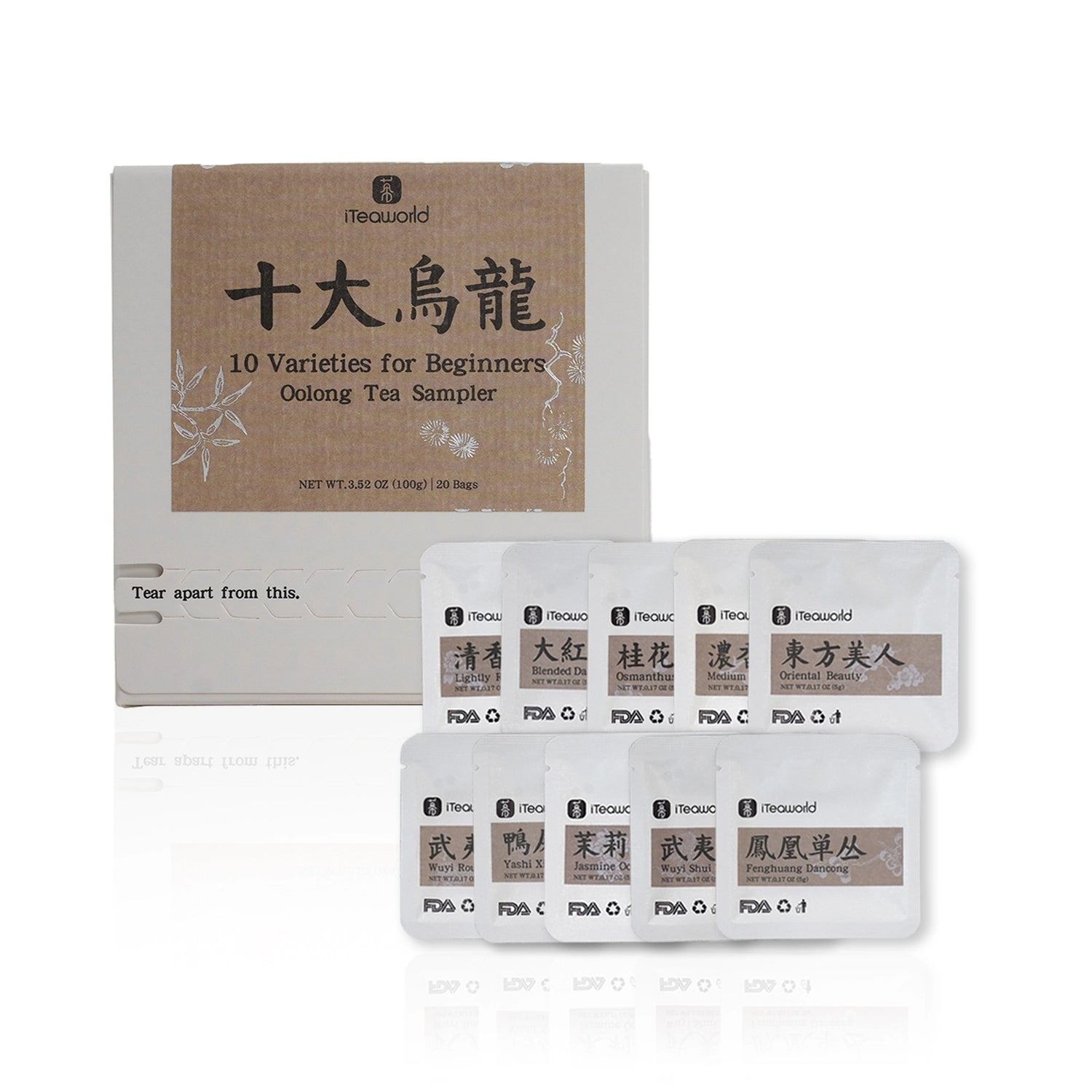

Коллекция улунских чаёв – 10 лучших классических чаёв для начинающих 100 г (20 пакетиков)
$19.99 USD
Цена за единицу товара заКоллекция улунских чаёв – 10 лучших классических чаёв для начинающих 100 г (20 пакетиков)
$19.99 USD
Цена за единицу товара заЛучшая коллекция улунского чая для начинающих, включающая 10 самых знаковых и популярных китайских улунских чаев, а также 2 мини-блинчика каждого сорта (всего 20 штук) .
Каждый чай изготавливается из тщательно отобранных листочков и прессуется в удобные мини-брикеты весом 5 г — просто бросьте их в горячую воду, никакие чайные принадлежности не требуются.
В этом тщательно подобранном наборе представлен широкий спектр натуральных вкусов улунов: от свежих цветочных нот Те Гуань Инь до насыщенного вкуса глубокой прожарки Да Хун Пао.
Абсолютно никакого добавленного сахара, искусственных ароматизаторов и красителей — только 100% натуральный чай.
Это идеальный способ познакомиться с настоящим китайским чаем улун и найти свои любимые сорта — путешествие в мир настоящего чая с минимальным риском и высокой ценностью без лишних хлопот.
Обратите внимание: поскольку мини-лепешки изготавливаются из целых листьев, которые размягчаются и прессуются, при заваривании могут появляться небольшие фрагменты листьев — это совершенно нормально и является частью натурального процесса заваривания чая.

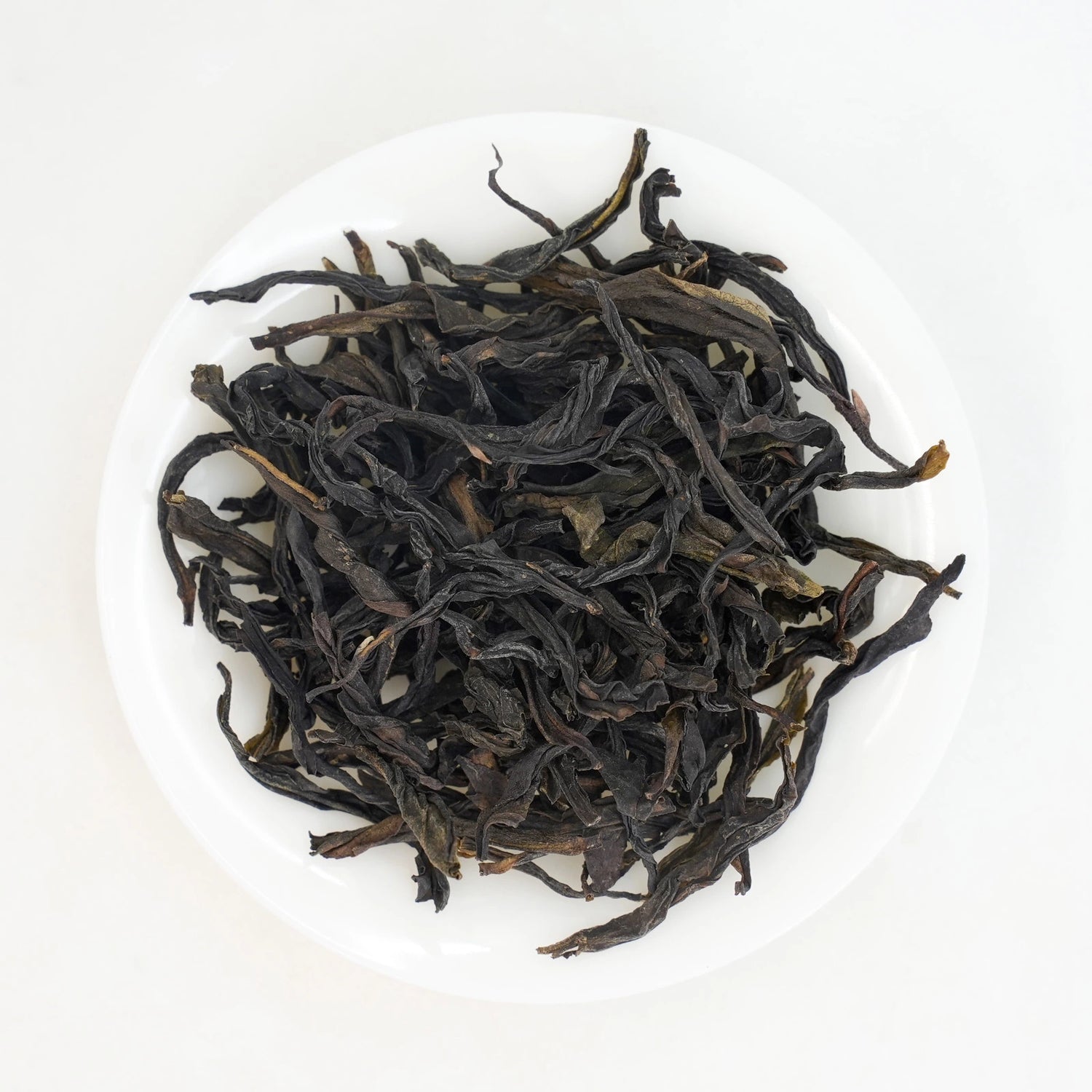
Чай Ya Shi Xiang Dancong Oolong для ежедневного употребления 100 г (весна 2025 г.)
$14.99 USD
Цена за единицу товара заЧай Ya Shi Xiang Dancong Oolong для ежедневного употребления 100 г (весна 2025 г.)
$14.99 USD
Цена за единицу товара заЯ Ши Сян Даньцун | 鸭屎香单丛乌龙茶
Несмотря на свое необычное название, Я Ши Сян (с ароматом утиного помёта) — один из самых любимых и доступных сортов улуна Даньцун. Этот чай, выращенный на горе Удун и собранный в апреле 2025 года, изготовлен из оригинального сорта Я Ши Сян, известного своим насыщенным цветочным ароматом и золотисто-сладковатым, словно нектар, вкусом.
Эта партия чая поступает из деревни Фэнси у водохранилища в городке Фэнхуан района Чаоань города Чаочжоу, провинция Гуандун. Расположенный на высоте 500–600 метров, этот район считается одним из лучших для производства чая Чжуншань Даньцун. Чуть выше расположен пояс гор среднегорья, но чаи с этой высоты уже считаются одними из лучших среди коммерческих сортов Даньцун, предлагая исключительное качество по выгодной цене.
Изготовленный методом легкой обжарки для сохранения его фирменного аромата, он отличается шелковистой текстурой, яркими цветочными нотами и продолжительным сладким послевкусием.
Происхождение: водохранилище Фэнси, город Феникс, Чаочжоу, провинция Гуандун.
Изготовитель чая: Лю Чэнпэн — мастер чайного дела во втором поколении с более чем 20-летним опытом работы в семье, которая на протяжении поколений изготавливает чай Даньцун.
Сорт: Я Ши Сян (Аромат утиного дерьма).
Урожай: апрель 2025 г. (весна)
Высота : 500-600 м
Окисление: среднее (40–50%)
Обжарка: светлая (традиционная обжарка на древесном угле)
Срок годности: 3 года
Хранение: хранить в герметичном контейнере в прохладном, сухом месте без посторонних запахов. Данцун слабой обжарки рекомендуется хранить в холодильнике, чтобы сохранить его цветочный аромат.
Вкус
Аромат: насыщенный цветочный — гардения, магнолия и мед
Вкус: насыщенный, нектаро-сладкий, с мягким телом и мягкими минеральными нотками.
Послевкусие: продолжительное, цветочно-сладкое с охлаждающим эффектом в горле.
Пивоварение
Сосуд: Фарфоровая гайвань / Глиняный горшок Чаочжоу
Вода: 95°C | 203°F
Метод Гайвань:
5–7 г на 100 мл, 1–3-й: 8–12 с. | 4-й и последующие: добавить 5–8 с. на каждый завар | До 9 заварок
Инструкции по приготовлению холодного напитка:
Используйте 3–5 г чая на 500 мл (около 17 унций) воды .
Совет по использованию воды: лучше всего подойдет родниковая или очищенная мягкая вода.
Плотно закройте контейнер и поместите в холодильник (39–46°F / 4–8°C) .
Дайте настояться в течение 6–8 часов (идеально заваривать перед сном и наслаждаться утром).
Примечание: Слишком короткое заваривание может привести к слабому аромату; более 10 часов заваривания могут вызвать легкую горечь.
Случаи
Идеально подходит для знакомства друзей с улунским чаем Даньцун.
Бодрящий послеобеденный аромат со сладким, цветочным настроением
Понравится всем — отлично подходит как для непринужденной, так и для целенаправленной дегустации.
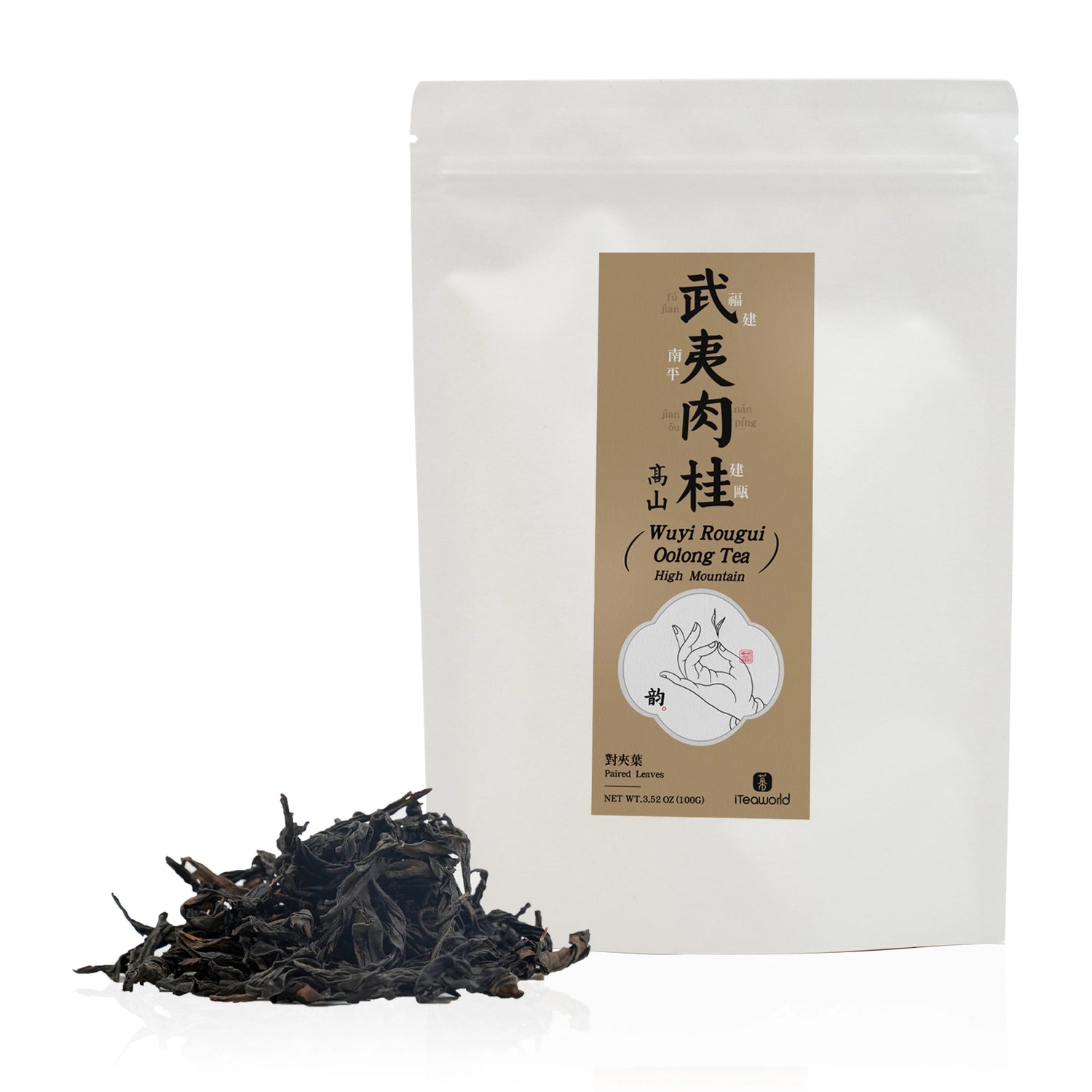

Улун Уи Жоу Гуй (высокогорный) – подходит для ежедневного употребления (весна 2025 г.)
От $1.99 USD
Цена за единицу товара заУлун Уи Жоу Гуй (высокогорный) – подходит для ежедневного употребления (весна 2025 г.)
От $1.99 USD
Цена за единицу товара за Уи Роу Гуй (Высокогорный Улун с корицей) | 武夷高山肉桂
Введение
«Жоу Гуй» — один из самых культовых улунов из Уи, известный своим ярким, пряным вкусом и фирменным ароматом с нотками корицы. Выращенный на каменистых, богатых минералами почвах и идеально обжаренный на углях, он дарит сложный, насыщенный вкус с многослойными нотами жареных специй, темных фруктов и влажной косточки.
Этот чай выращивается в деревне Байчжан в городке Сяоцяо, недалеко от живописного центра Уишань. Хотя Байчжан и не входит в официальную зону «Чжэн Янь», он может похвастаться более чем 1000-летней историей чаеварения и когда-то был производителем чая, приносившего императорские пожертвования. Расположенный на высоте 730 метров над уровнем моря высокогорный терруар — туманный климат, песчано-гравийные почвы и богатый минеральный состав — отвечает классическим критериям производства исключительного горного улуна по выдающейся цене.
После тщательной дегустации чая «Жоу Гуй» со всех лучших районов Уи мы выбрали этот чай за его исключительный баланс вкуса, структуры и цены, что делает его нашим лучшим выбором для ежедневного употребления «Жоу Гуй» с истинным характером.
Происхождение: деревня Байчжан, город Сяоцяо, город Цзяноу, Фуцзянь, Китай | 730 м
Обжарка: традиционная обжарка на древесном угле (метод брикетирования)
Чайник: Чжэн Сюнцин, опытный мастер чайного дела из многопоколенческой семьи, занимающейся чаеварением.
Культивар: Rou Gui
Урожай: 2025 (весна)
Окисление: средне-высокое (50–60%)
Обжарка: средне-сильная (обжарка на углях)
Срок годности: 3 года
Хранение: хранить в герметичном контейнере в прохладном, сухом месте без посторонних запахов. Для более длительного хранения или ускорения созревания избегайте частого контакта с воздухом.
Пивоварение
-
Сосуд: Фарфоровая гайвань / глиняный чайник
-
Вода: 100 мл родниковой/чистой воды : 5 г чая | 100°C / 212°F
-
Замачивание:
-
1–3-я инфузии: 10–15 секунд
-
Последующие заваривания: добавляйте 5–7 секунд на каждый раунд.
-
Подходит для 8–10 заварок
-
Вкус
-
Аромат: жареные специи, корица, богатый минералами
-
Вкус: насыщенный и согревающий, с нотами темных фруктов и минеральностью горных пород.
-
Ощущение во рту: густое, структурированное, с длительным резонансом
-
Послевкусие: Длительное «рок-рифмование» (岩韵) с пряным послевкусием
Случаи
-
Утренний фокус (стимулирующий и заземляющий)
-
Ясность после еды (уменьшает тяжесть)
-
Идеальный уишаньский улун на каждый день для любителей ярких вкусов
Recently viewed products
Chat with fellow tea lovers, ask questions, and share your tea moments.






